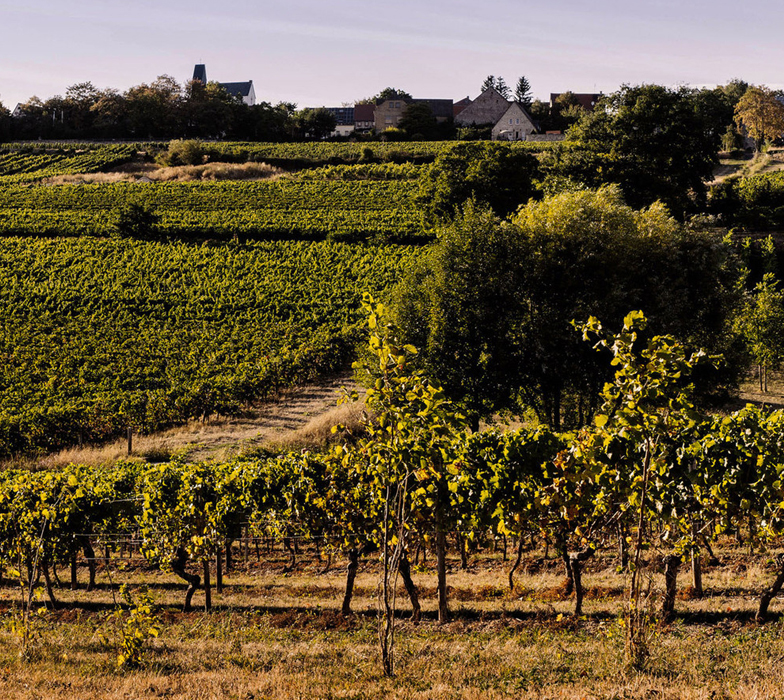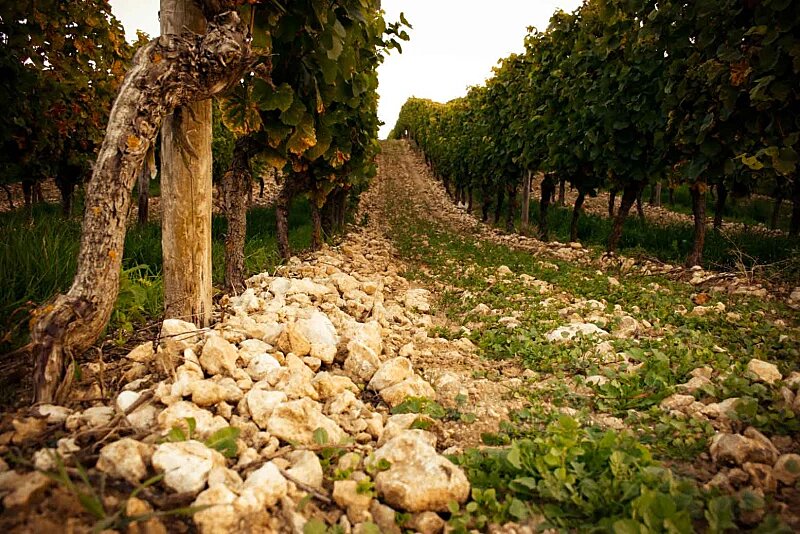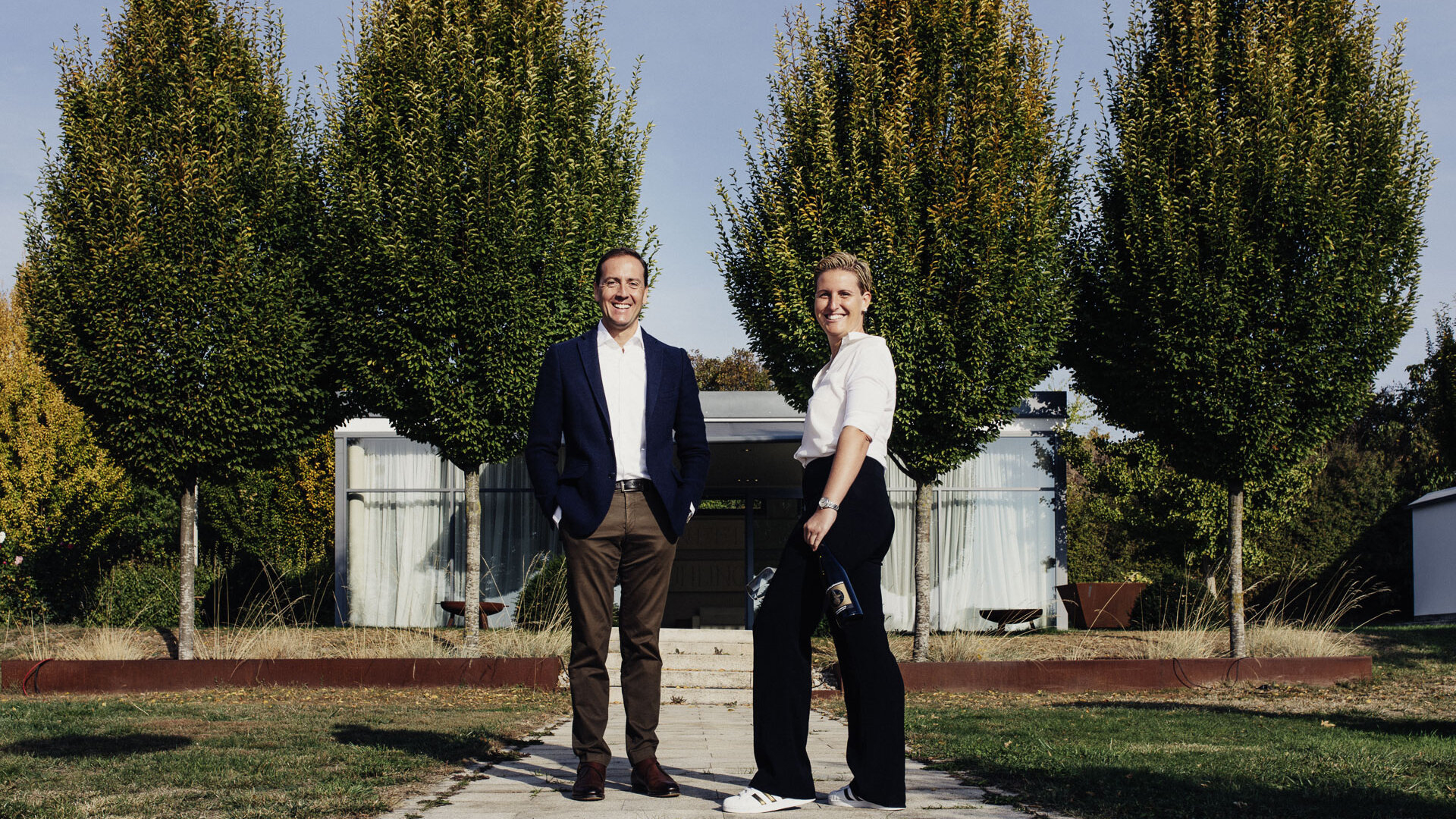
Battenfeld-Spanier
Battenfeld-Spanier
The dynamic husband-wife team of H. O. Spanier and CarolinSpanier-Gillot is the driving force behind the Battenfeld Spanier Estate. The Magic is hidden deep beneath the soil of this outstanding winery located in Rheinhessen, namely layers of lime that add precise, vibrant minerality across the...
Read More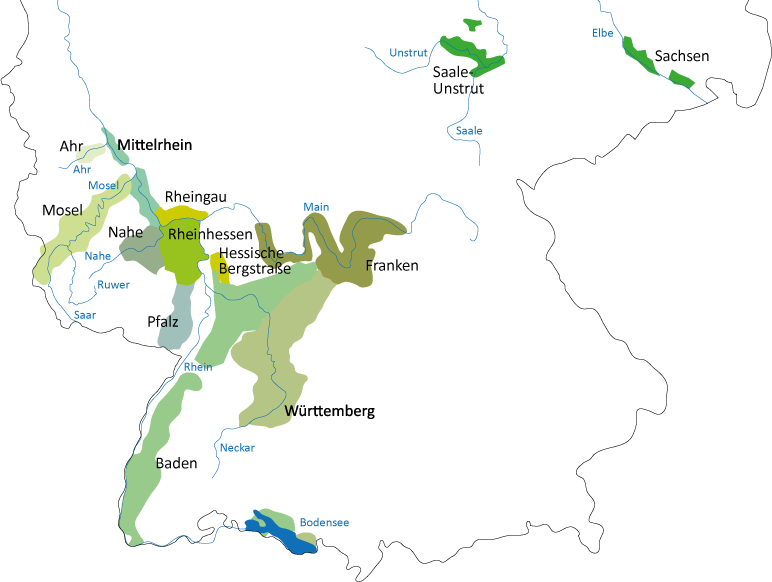
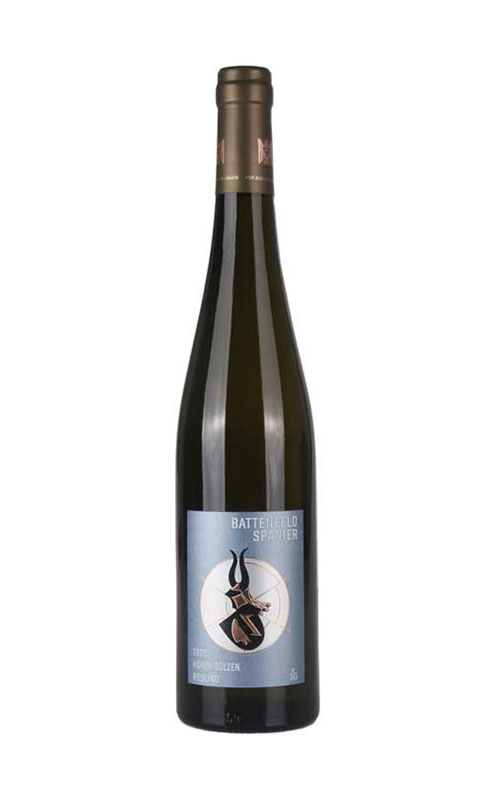
2021 Hohen-Sülzen Riesling
The Erste Lage classification denotes world-class vineyards of especially notable characteristics: Hohen-Sülzen lies along the Eisbachtal. This river flows from the Donnersberg massif and exerts a significant climatic influence on the valley. The fluctuations between daytime and night-time temperature are more pronounced in Hohen-Sülzen than in other districts. This gives the wines their freshness, elegance, and tension despite the rich ripeness of the grapes.
The vines grow on pure limestone with a generous deposit of loess and are characterized by their ripe fruit, fine spice, and nuanced acidity. The wine is selectively hand-harvested, wild fermented, and raised in Stück and Doppelstück barrels. Shades of pale yellow, with green hues and a silver rim show in the glass. Yellow stone fruit and spice weave an aromatic web around the nose of this Hohen-Sülzen Riesling. Peach, dried apricot, and Mirabelle plum shine, followed by dried herbs, light tobacco, laurel, and the delicate spice of mace and white pepper. A linear palate blends ripe, juicy fruit with savory spice and deep, smoky minerality. This is an unforgettable wine with delicate fruit, saline finish, and indisputable origin. Given its precise, cool, and refreshing nature, it offers countless options for pairing with fish dishes, sushi, or crisp mixed vegetables from the wok.
Ratings
93 James Suckling points | 16.5 Jancis Robinson points
Wine Facts
- Riesling
- Dry
- VDP.ERSTE LAGE
- Hohen-Sülzen
- South, Southwest
- 500ft Elevation, 15% gradient
- Limestone with Loess, Loam
- 0.75Ltr
- 7g/l
- 3g/l
- 12%
- 6-8°C
- Now-2040
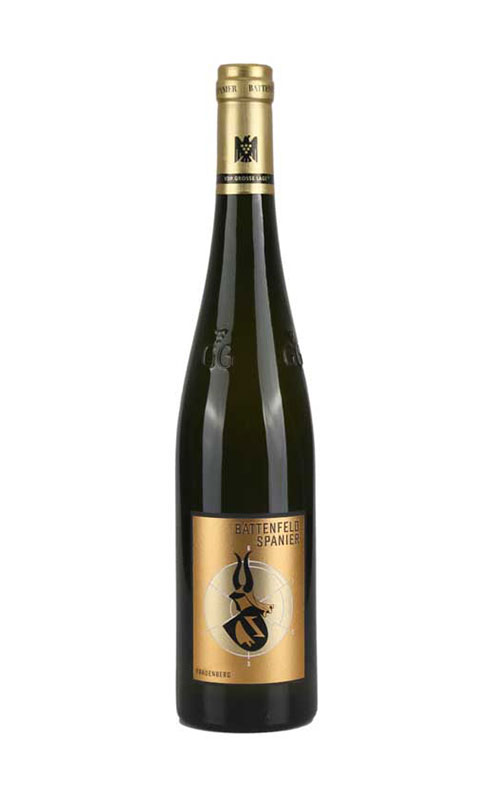
2021 Frauenberg Riesling
The Frauenberg lies in the southern Wonnegau, north of Hohen-Sülzen heading towards Flörsheim at an elevation of up to 280 meters and up to 40% gradient. The historic site can be traced back through official documents to at least 1290, where it was called the “an frauwenhalten” and was the site of a nunnery. H.O. Spanier rescued the Frauenberg from oblivion and placed it back in the consciousness of wine lovers. While purely south facing, the exposed site on the Frauenberg experiences constant cooling winds, with a broken limestone top layer and a base substrate of solid limestone. The vines dig deep into the hard, mineral-rich soil. This lends them a self-sustaining character and allows for long, healthy vegetative periods, even in extreme years. Wines from the Frauenberg are meticulously hand-selected and harvested, wild fermented and matured in Stück and Doppelstück barrels.
Bright straw-yellow, it has shimmering hues and a silver rim. In its youth, Frauenberg is more of a sketch than a highly shaded and detailed self-portrait. Stony and austere, it is reminiscent of wet gravel while cooling notes of fresh chervil and cucumber peel complement the citrus fruit, apricot stone, and apple skin. Unmistakable dark aromatics and smoky overtones deliberately shape the precise outline. A pulsating pressure builds on the tense palate, even as the nearly orchestral acidity acts like a conductor, guiding extract, phenolics, and minerality to each play their part. Complex and nuanced, it is a wine whose potential requires not only a decanter but also a few years of bottle maturation. Frauenberg is a mineral-driven wine with a tremendous affinity for fine cuisine. Lobster, seafood, sashimi, and dishes that feature soy sauce make for great pairings, while finely-prepared German classics like KönigsbergerKlopse and Braten in horseradish sauce push it toward the sublime.
Ratings
96 James Suckling points | 17 Jancis Robinson points
Wine Facts
- Riesling
- VDP.GROSSE LAGE
- Frauenberg
- South, Southwest
- 1200ft Elevation, 10% gradient
- Loess, Limestone, Stomy Clay Loam
- 0.75Ltr
- 7.2g/l
- 3g/l
- 12.5%
- 6-8°C
- Now-2040

2020-Frauenberg Riesling
The Frauenberg lies in the southern Wonnegau, north of Hohen-Sülzen heading towards Flörsheim at an elevation of up to 280 meters and up to 40% gradient. The historic site can be traced back through official documents to at least 1290, where it was called the “an frauwenhalten” and was the site of a nunnery. H.O. Spanier rescued the Frauenberg from oblivion and placed it back in the consciousness of wine lovers. While purely south facing, the exposed site on the Frauenberg experiences constant cooling winds, with a broken limestone top layer and a base substrate of solid limestone. The vines dig deep into the hard, mineral-rich soil. This lends them a self-sustaining character and allows for long, healthy vegetative periods, even in extreme years. Wines from the Frauenberg are meticulously hand-selected and harvested, wild fermented and matured in Stück and Doppelstück barrels.
Bright straw-yellow, it has shimmering hues and a silver rim. In its youth, Frauenberg is more of a sketch than a highly shaded and detailed self-portrait. Stony and austere, it is reminiscent of wet gravel while cooling notes of fresh chervil and cucumber peel complement the citrus fruit, apricot stone, and apple skin. Unmistakable dark aromatics and smoky overtones deliberately shape the precise outline. A pulsating pressure builds on the tense palate, even as the nearly orchestral acidity acts like a conductor, guiding extract, phenolics, and minerality to each play their part. Complex and nuanced, it is a wine whose potential requires not only a decanter but also a few years of bottle maturation. Frauenberg is a mineral-driven wine with a tremendous affinity for fine cuisine. Lobster, seafood, sashimi, and dishes that feature soy sauce make for great pairings, while finely-prepared German classics like KönigsbergerKlopse and Braten in horseradish sauce push it toward the sublime.
Ratings
18 Jancis Robinson points | 95 Robert Parker points
Wine Facts
- Riesling
- VDP.GROSSE LAGE
- Frauenberg
- South, Southwest
- 1200ft Elevation, 10% gradient
- Loess, Limestone, Stomy Clay Loam
- 0.75Ltr
- 7.2g/l
- 3g/l
- 12.5%
- 6-8°C
- Now-2040
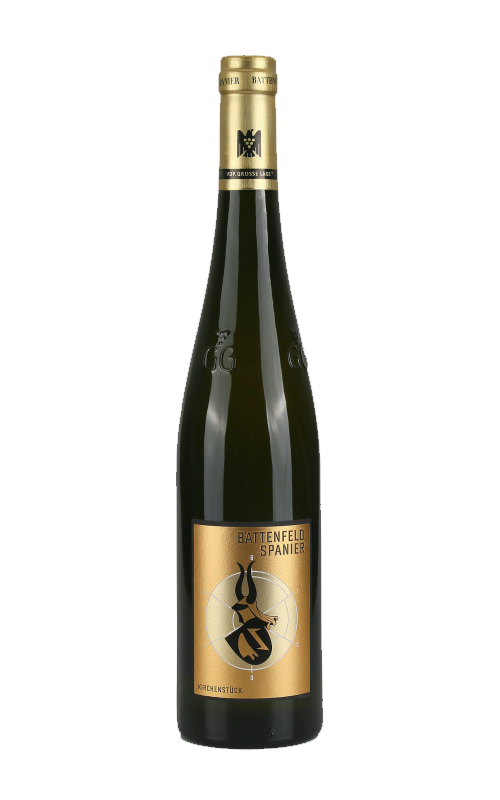
2021 Kirchenstück Riesling
The Kirchenstück is mentioned by name in official documents predating the Thirty Years War. Situated at an elevation of 150 meters on a plateau between two churches, it overlooks H.O.’s hometown of Hohen-Sülzen. Its ancient centerpiece is home to his oldest vineyards, planted in the 1960s. Today the wines come from the best parcels of the entire Kirchenstück — average vine age: 35 years — for wines of notable fruit and depth. The soft, calcareous stone of the upper soil provides an excellent nutritional supply despite an extremely calcareous substrate. Characterized by its expressive fruit, the Kirchenstück is accessible starting in youth, yet promises immense development potential over time. Wines from the Kirchenstück are
meticulously hand selected, wild fermented and matured in Stück and Doppelstück barrels.
The wine shimmers in shades of pale straw yellow, shifting and changing in the large bowled glass to reveal a nose of juicy fruit and the captivating herbal spice of water mint, lemon-thyme and savory. The green herbal spice is then underscored with yellow and red fruit aromas. Notes of fully ripe yellow apple and quince as well as nectarine are underpinned by accents of wet chalk. Concentrated fruit with a mouthwatering, fine-grained phenolic comes alive to a youthful, electric nerve of acidity. Complex and deep, the wine moves with enviable confidence and focus across the palate and toward its steadfast and salty mineral finish. The Kirchenstück is notably openspirited in its youth, yet don’t sleep on its enormous maturation ceiling and well-deserved claim as an accompaniment to fine cuisine: North African or Levant cooking are ideal pairings, as are fish and seafood classics from the French tradition.
Ratings
93 James Suckling points | 17.5 Jancis Robinson points
Wine Facts
- Riesling
- Dry
- VDP.GROSSE LAGE
- Kirchenstück
- South
- Soft Elevation, 15% gradient
- Limestone, Loamy Loess
- 0.75Ltr
- 8.5g/l
- 0.3g/l
- 12.5%
- 6-8°C
- Now-2045
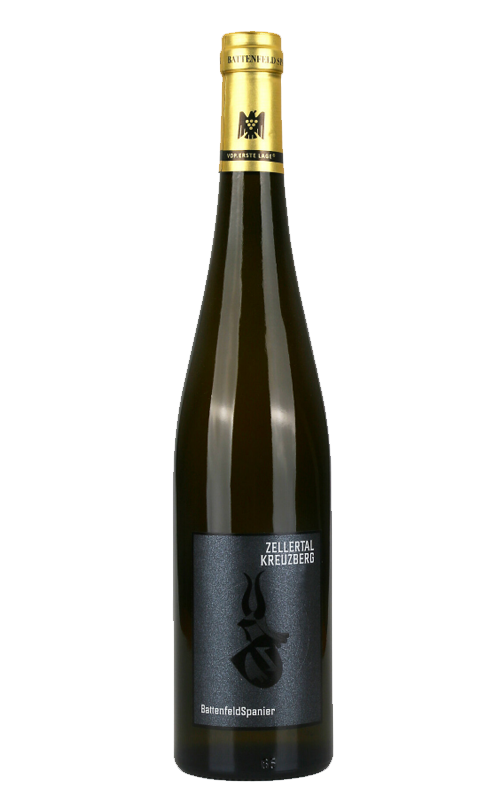
2021 Zeller Kreuzberg Riesling Pfalz
The Zellertal has seen winegrowing since the 8th century, placing it squarely among the oldest winegrowing regions anywhere in Germany. Nevertheless, it was all but forgotten in the 20th century until H.O. Spanier chose it, after the Frauenberg and Schwarzer Herrgott, as his next project to restore to the consciousness of wine lovers. The Kreuzberg lies just below the Schwarzer Herrgott and in fact looks up to the Herrgott’s black Kreuz (‘cross’), earning it the name “Zellertal Kreuzberg.” Geologically, the Zellertal Kreuzberg is just as unique as the Schwarzer Herrgott, standing on a massive bank of limestone running from Rheinhessen’s Frauenberg into the Pfalz portion of the Zellertal and known for producing wines of an incredibly
mineral character. The Kreuzberg Riesling has been classified as a GG since the 2020 vintage, thus making it the first Großes Gewächs from the Pfalz in our portfolio. Hand harvested and wild fermented, the Kreuzberg Riesling is raised in traditional Halbstück barrels and matured on the fine lees until the summer after harvest. The wine winks with shades of pale straw in the glass, and soon overcomes its initial hesitation to reveal that it is anything but reliant on primary fruits. It is notably stony and austere, with salty aromas redolent of a refreshing sea breeze and underscored with aromas of sage and goutweed. Refined and complex, the palate balances an concentrated extracts and reductive fruit against a notably salty soul. Using the tremendous tension and momentum, it blends finesse and elegance with the distinctive minerality of the Zellertal’s limestone soils. A clear occasion to bring out the big glasses, to best enjoy its tremendous development potential. The 2021 Zeller Kreuzberg Riesling GG is exclusively being offered at the VDP.AUCTIONS in Bad Kreuznach.
Ratings
93 James Suckling points | 17.5 Jancis Robinson points
Wine Facts
- Riesling
- Dry
- VDP.GROSSE LAGE
- Kreuzberg
- South
- Soft Elevation, 15% gradient
- Limestone, Loamy Loess
- 0.75Ltr
- 8.0g/l
- 0.3g/l
- 12.5%
- 6-8°C
- Now-2045
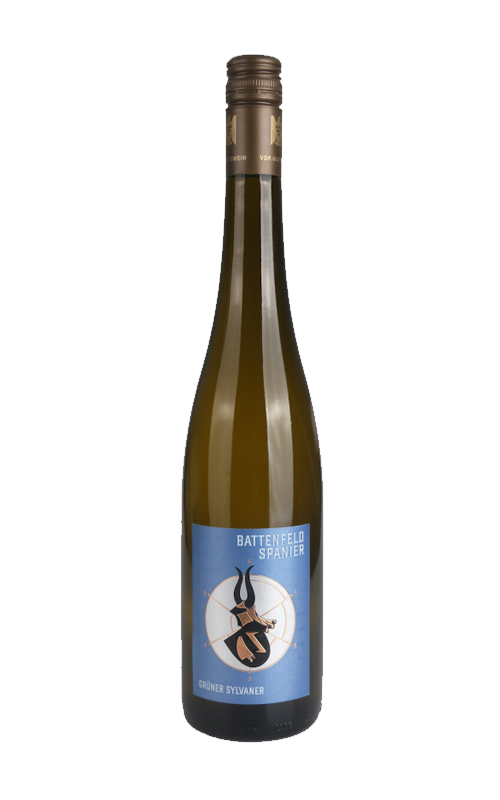
2021 Grüner Sylvaner Trocken
Although considered a native of Franken, Grüner Sylvaner also looks back on a long tradition in the Wonnegau, and could well be the original rootstock of Rheinhessen. When grown on calcareous soils around Hohen-Sülzen, it perpetually develops a certain herbal spice. Grüner Sylvaner is raised in steel and wild fermented to be bone dry.
The wine graces the glass in shades of pale yellow with green hues: Yellow fruit aromas, with notes of nectarine and small yellow pear, are balanced with spring kitchen herbs. The crystalline palate is linear and precise, with everything in the right place: the fruit is flanked by a drying texture, with mild and perfectly integrated acidity. Our Grüner Sylvaner is an ace up the sleeve for a colorful range of vegetable dishes, pairing deftly with salads and light dishes just as well as hearty ones such as a classic German Wurstsalat.
Ratings
93 James Suckling points | 17.5 Jancis Robinson points
Wine Facts
- Grüner Sylvaner
- Dry
- ORTSWEIN
- Limestone, Loamy Loess
- 0.75Ltr
- 6.5g/l
- 0.3g/l
- 12 %
- 6-8°C
- Now-2045
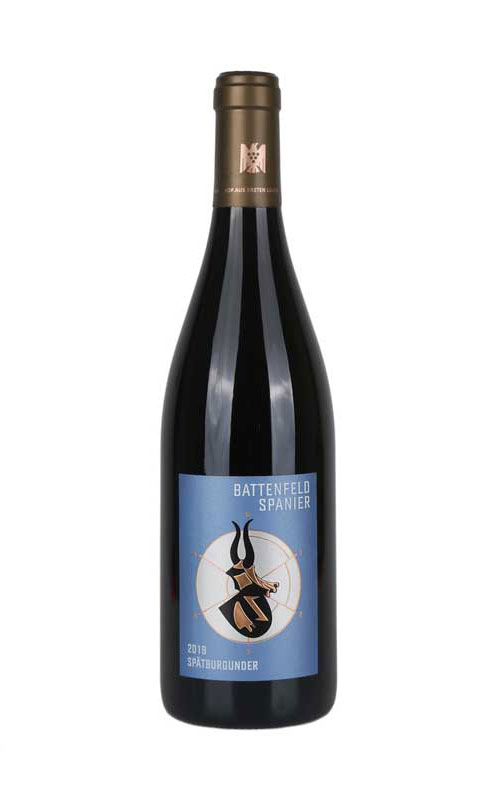
2020 Spätburgunder
The southern Wonnegau has been known since medieval times for achieving ripeness in grape varieties that fail to thrive in cooler places. Spätburgunder has always been part of that equation, and can virtually be counted as a native of this place. While days in the Wonnegau can be very hot, the cool nights mean overall higher diurnal temperature swings than in other districts. Harvested ripe — but never overripe — we raise our estate-level Spätburgunder Gutswein in barrique and French tonneaux. This provides the first encounter between wine and oxygen, accentuating the delicate fruit of the Spätburgunder with earthy spice. The wine shines a deep ruby red in the glass with aromas of red berry fruit and ripe cherries. Underscored with delicate herbal nuances, it is juicy and refreshing with charming fruit, subtle spice, and refined tannins that give it a thrilling texture. From a wurst sandwich to pasta, an uncomplicated, joyous Spätburgunder complements any day or dish.
Ratings
16 Jancis Robinson points
Wine Facts
- Pinot Noir
- Dry
- VDP.GUTSWEIN
- Limestone and Loess
- 0.75Ltr
- 5.5g/l
- 0.3g/l
- 12.5%
- 17-19°C
- Now-2040
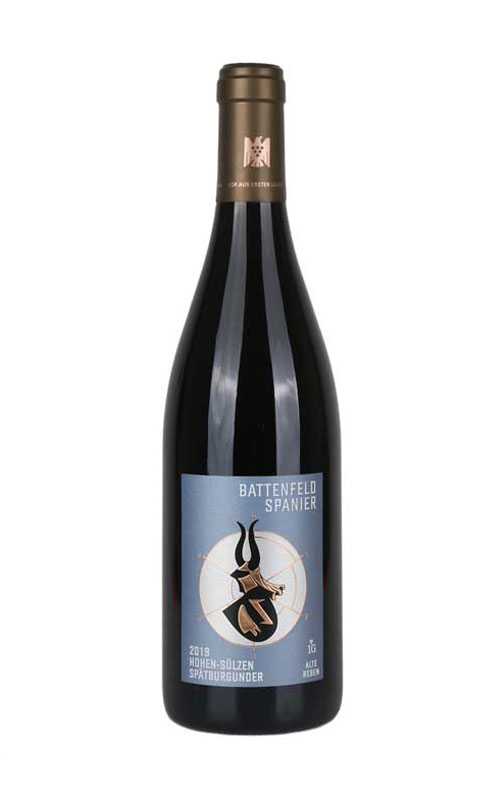
2019 Hohen-Sülzen Spätburgunder
The Erste Lage classification denotes world-class vineyards of especially notable characteristics: Hohen-Sülzen lies along the Eisbachtal. This river flows from the Donnersberg massif and exerts a significant climatic influence on the valley. The fluctuations between daytime and night-time temperature are more pronounced in Hohen-Sülzen than in other districts. This gives the wine its freshness, elegance, and tension. The vines grow on pure limestone with a generous deposit of loess and are characterized by their ripe fruit, fine spice, and nuanced acidity. The grapes for this wine were selectively hand-harvested, wild fermented, and matured for 18 months in French barriques. With shades of deep ruby, Hohen-Sülzen Spätburgunder reveals aromas of dark berries such as blackberry and elderberry. The sublime touch of barrel spice complements the fruit, with mild accents of allspice and nutmeg. It’s chiseled and elegant on the palate, with generous dark fruit and youthful, polished tannins. A delicate salty minerality and striking verve carry the fruit across the spicy-cool finish line. A delightful pairing with Boeuf Bourgignon, roasted pigeon, or Sicilian parmigiana.
Ratings
16.5 Jancis Robinson points
Wine Facts
- Pinot Noir
- Dry
- VDP.ERSTE LAGE
- Hohen-Sülzen
- South, Southwest
- 500ft Elevation, 15% gradient
- Limestone and Loess
- 0.75Ltr
- 5.8g/l
- 0.3g/l
- 12.5%
- 17-19°C
- Now-2040
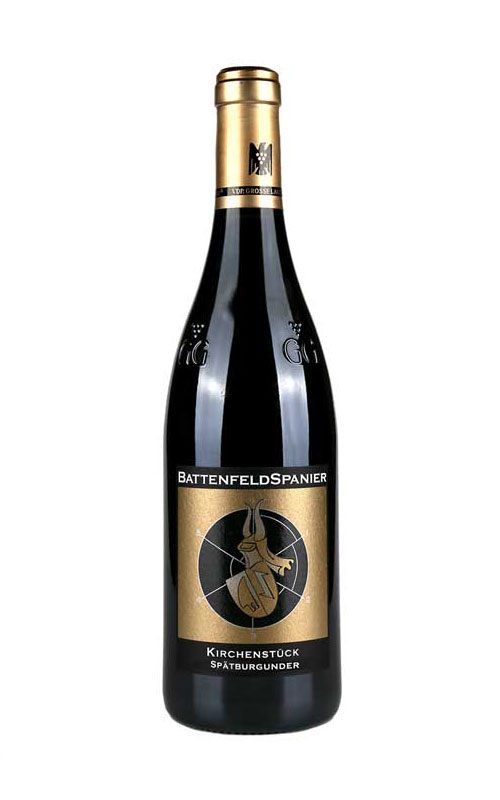
2020 Kirchenstück Spätburgunder
The Kirchenstück is our flagship in Hohen-Sülzen. It is a very old vineyard, which is already mentioned in documents before the 30-year war. Its original name was Griebelsteyn-and this vociferous name is very apt. Kirchenstück consists of soft, limestone stones and daytime temperatures are always a little higher than in our locations in Mölsheim or Nieder-Flörsheim. Hohen-Sülzen lies in the Eisbach Valley where, as the name suggests, the cold stream, which originates in the Donnersberg massif, exerts a considerable influence with cooler nights. As a result, despite the high grape ripeness, the wines retain their freshness, elegance, and acidity. This Spätburgunder comes from our oldest Pinot Noir vines. The yields are extremely low and the chalky underfloor brings a wonderfully cool freshness to the wine. The dark fruit aromas of currant and black cherry are restrained. In the mouth, the wine remains dark and spicy, and minerality dominates. This Spätburgunder matured in one-year-old barrels from Burgundy for almost two years.
Ratings
93 James Suckling points | 17.5 Jancis Robinson points
Wine Facts
- Pinot Noir
- Dry
- VDP.GROSSE LAGE
- Kirchenstück
- South
- Soft Elevation, 15% gradient
- Limestone, Loamy Loess
- 0.75Ltr
- 5.7g/l
- 0.3g/l
- 13.5%
- 17-19°C
- Now-2045
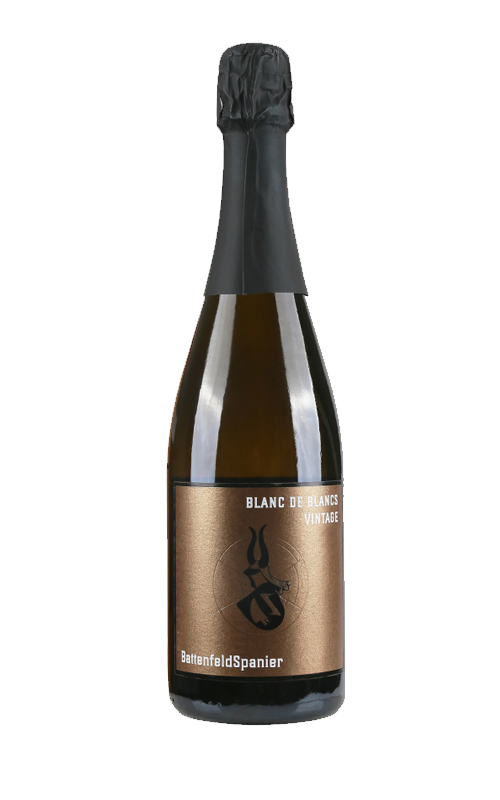
2012 Blanc De Blancs Prestige
Battenfeld Spanier Blanc de Blancs Sekt Prestige is made from our plots of Chardonnay located in Hohen-Sülzen. The climate here is perfect to grow Chardonnay in a very fresh and elegant style. First to be harvested, these grapes have to remain low in sugar and high in acidity in order to evolve nicely along the years.
The whole bunches are gently pressed in order to start the vinification of this premium traditional method. The juice is then fermented in French oak tonneaux (second & third use) and stay until June on its fine lees.
After racking the wine, it is bottled with a capsule in order to start the second fermentation. Finally, after 9 years on its lees, our Blanc de Blancs Sekt Prestige
2012 was disgorged.
The 2012 vintage is firm and deep. It shows yeasty character traduced by a nutty, citric tart and brioche aroma, along with delicate floral and stone fruit nuances.
The flavours are clear and the wine is dry. Despite a long time on the lees, it is juicy with ripe and dry fruits, creamy and smoky taste. Let it breathe to show complex flavours of candy, patisserie and a finely spicy finish
Ratings
93 James Suckling points | 17.5 Jancis Robinson points
Wine Facts
- Chardonnay
- Dry
- VDP.GROSSE LAGE
- Limestone, Loamy Loess
- 0.75Ltr
- 5.7g/l
- 0.3g/l
- 13.5%
- 6-8°C
- Now-2045
Battenfeld-Spanier, rheinhessen
The dynamic husband-wife team of H. O. Spanier and CarolinSpanier-Gillot is the driving force behind the Battenfeld Spanier Estate. The Magic is hidden deep beneath the soil of this outstanding winery located in Rheinhessen, namely layers of lime that add precise, vibrant minerality across the spectrum of their varietals: Riesling, Spätburgunder (Pinot Noir), and Silvaner. Cellarmaster H. O. has combined the perfectionism developed during an early career in sport with the trust in nature that goes hand-in-hand with the finest wine-making. When applied to organic and bio-dynamic vineyard and winery principles this combination of skill and intuition yields wines crafted almost single-handedly by a rich and unique terroir. The result is the estate’s incomparable Silver-label Riesling and vibrant Spätburgunder and Silvaner. Battenfeld Spanier has 48,000 acres of holdings near Worms across from Wonnegau, Hohen-Sülzen, and the Zellertal and has been a proud member of the VDP since 2008.
2021 Hohen-Sülzen Riesling
The Erste Lage classification denotes world-class vineyards of especially notable characteristics: Hohen-Sülzen lies along the Eisbachtal. This river flows from the Donnersberg massif and exerts a significant climatic influence on the valley. The fluctuations between daytime and night-time temperature are more pronounced in Hohen-Sülzen than in other districts. This gives the wines their freshness, elegance, and tension despite the rich ripeness of the grapes. The vines grow on pure limestone with a generous deposit of loess and are characterized by their ripe fruit, fine spice, and nuanced acidity. The wine is selectively hand-harvested, wild fermented, and raised in Stück and Doppelstück barrels. Shades of pale yellow, with green hues and a silver rim show in the glass. Yellow stone fruit and spice weave an aromatic web around the nose of this Hohen-Sülzen Riesling. Peach, dried apricot, and Mirabelle plum shine, followed by dried herbs, light tobacco, laurel, and the delicate spice of mace and white pepper. A linear palate blends ripe, juicy fruit with savory spice and deep, smoky minerality. This is an unforgettable wine with delicate fruit, saline finish, and indisputable origin. Given its precise, cool, and refreshing nature, it offers countless options for pairing with fish dishes, sushi, or crisp mixed vegetables from the wok.
Tasting Notes
Wine Facts
- Riesling
- Dry
- VDP.ERSTE LAGE
- Hohen-Sülzen
- South, Southwest
- 500ft Elevation, 15% gradient
- Limestone with Loess, Loam
- 0.75Ltr
- 7g/l
- 3g/l
- 12%
- 6-8°C
- Now-2040

Wunderwein LLC | 67 Midland Boulevard | Maplewood | 07040 | New Jersey | www.wunderwein.com | jan@wunderwein.com
Importer of record: Park Street Imports | 1000 Brickell Ave | Suite 915 | Miami, FL 33131
IMPORTER PERMIT NUMBER: FL-I-15704
TAX ID NUMBER: 37-1601874
Battenfeld-Spanier, rheinhessen
The dynamic husband-wife team of H. O. Spanier and CarolinSpanier-Gillot is the driving force behind the Battenfeld Spanier Estate. The Magic is hidden deep beneath the soil of this outstanding winery located in Rheinhessen, namely layers of lime that add precise, vibrant minerality across the spectrum of their varietals: Riesling, Spätburgunder (Pinot Noir), and Silvaner. Cellarmaster H. O. has combined the perfectionism developed during an early career in sport with the trust in nature that goes hand-in-hand with the finest wine-making. When applied to organic and bio-dynamic vineyard and winery principles this combination of skill and intuition yields wines crafted almost single-handedly by a rich and unique terroir. The result is the estate’s incomparable Silver-label Riesling and vibrant Spätburgunder and Silvaner. Battenfeld Spanier has 48,000 acres of holdings near Worms across from Wonnegau, Hohen-Sülzen, and the Zellertal and has been a proud member of the VDP since 2008.
2021 Frauenberg Riesling
The Frauenberg lies in the southern Wonnegau, north of Hohen-Sülzen heading towards Flörsheim at an elevation of up to 280 meters and up to 40% gradient. The historic site can be traced back through official documents to at least 1290, where it was called the “an frauwenhalten” and was the site of a nunnery. H.O. Spanier rescued the Frauenberg from oblivion and placed it back in the consciousness of wine lovers. While purely south facing, the exposed site on the Frauenberg experiences constant cooling winds, with a broken limestone top layer and a base substrate of solid limestone. The vines dig deep into the hard, mineral-rich soil. This lends them a self-sustaining character and allows for long, healthy vegetative periods, even in extreme years. Wines from the Frauenberg are meticulously hand-selected and harvested, wild fermented and matured in Stück and Doppelstück barrels. Bright straw-yellow, it has shimmering hues and a silver rim. In its youth, Frauenberg is more of a sketch than a highly shaded and detailed self-portrait. Stony and austere, it is reminiscent of wet gravel while cooling notes of fresh chervil and cucumber peel complement the citrus fruit, apricot stone, and apple skin. Unmistakable dark aromatics and smoky overtones deliberately shape the precise outline. A pulsating pressure builds on the tense palate, even as the nearly orchestral acidity acts like a conductor, guiding extract, phenolics, and minerality to each play their part. Complex and nuanced, it is a wine whose potential requires not only a decanter but also a few years of bottle maturation. Frauenberg is a mineral-driven wine with a tremendous affinity for fine cuisine. Lobster, seafood, sashimi, and dishes that feature soy sauce make for great pairings, while finely-prepared German classics like KönigsbergerKlopse and Braten in horseradish sauce push it toward the sublime.
Tasting Notes
Wine Facts
- Riesling
- VDP.GROSSE LAGE
- Frauenberg
- South, Southwest
- 1200ft Elevation, 10% gradient
- Loess, Limestone, Stomy Clay Loam
- 0.75Ltr
- 7.2g/l
- 3g/l
- 12.5%
- 6-8°C
- Now-2040

Wunderwein LLC | 67 Midland Boulevard | Maplewood | 07040 | New Jersey | www.wunderwein.com | jan@wunderwein.com
Importer of record: Park Street Imports | 1000 Brickell Ave | Suite 915 | Miami, FL 33131
IMPORTER PERMIT NUMBER: FL-I-15704
TAX ID NUMBER: 37-1601874
Battenfeld-Spanier, rheinhessen
The dynamic husband-wife team of H. O. Spanier and CarolinSpanier-Gillot is the driving force behind the Battenfeld Spanier Estate. The Magic is hidden deep beneath the soil of this outstanding winery located in Rheinhessen, namely layers of lime that add precise, vibrant minerality across the spectrum of their varietals: Riesling, Spätburgunder (Pinot Noir), and Silvaner. Cellarmaster H. O. has combined the perfectionism developed during an early career in sport with the trust in nature that goes hand-in-hand with the finest wine-making. When applied to organic and bio-dynamic vineyard and winery principles this combination of skill and intuition yields wines crafted almost single-handedly by a rich and unique terroir. The result is the estate’s incomparable Silver-label Riesling and vibrant Spätburgunder and Silvaner. Battenfeld Spanier has 48,000 acres of holdings near Worms across from Wonnegau, Hohen-Sülzen, and the Zellertal and has been a proud member of the VDP since 2008.
2020-Frauenberg Riesling
The Frauenberg lies in the southern Wonnegau, north of Hohen-Sülzen heading towards Flörsheim at an elevation of up to 280 meters and up to 40% gradient. The historic site can be traced back through official documents to at least 1290, where it was called the “an frauwenhalten” and was the site of a nunnery. H.O. Spanier rescued the Frauenberg from oblivion and placed it back in the consciousness of wine lovers. While purely south facing, the exposed site on the Frauenberg experiences constant cooling winds, with a broken limestone top layer and a base substrate of solid limestone. The vines dig deep into the hard, mineral-rich soil. This lends them a self-sustaining character and allows for long, healthy vegetative periods, even in extreme years. Wines from the Frauenberg are meticulously hand-selected and harvested, wild fermented and matured in Stück and Doppelstück barrels. Bright straw-yellow, it has shimmering hues and a silver rim. In its youth, Frauenberg is more of a sketch than a highly shaded and detailed self-portrait. Stony and austere, it is reminiscent of wet gravel while cooling notes of fresh chervil and cucumber peel complement the citrus fruit, apricot stone, and apple skin. Unmistakable dark aromatics and smoky overtones deliberately shape the precise outline. A pulsating pressure builds on the tense palate, even as the nearly orchestral acidity acts like a conductor, guiding extract, phenolics, and minerality to each play their part. Complex and nuanced, it is a wine whose potential requires not only a decanter but also a few years of bottle maturation. Frauenberg is a mineral-driven wine with a tremendous affinity for fine cuisine. Lobster, seafood, sashimi, and dishes that feature soy sauce make for great pairings, while finely-prepared German classics like KönigsbergerKlopse and Braten in horseradish sauce push it toward the sublime.
Tasting Notes
Wine Facts
- Riesling
- VDP.GROSSE LAGE
- Frauenberg
- South, Southwest
- 1200ft Elevation, 10% gradient
- Loess, Limestone, Stomy Clay Loam
- 0.75Ltr
- 7.2g/l
- 3g/l
- 12.5%
- 6-8°C
- Now-2040

Wunderwein LLC | 67 Midland Boulevard | Maplewood | 07040 | New Jersey | www.wunderwein.com | jan@wunderwein.com
Importer of record: Park Street Imports | 1000 Brickell Ave | Suite 915 | Miami, FL 33131
IMPORTER PERMIT NUMBER: FL-I-15704
TAX ID NUMBER: 37-1601874
Battenfeld-Spanier, rheinhessen
The dynamic husband-wife team of H. O. Spanier and CarolinSpanier-Gillot is the driving force behind the Battenfeld Spanier Estate. The Magic is hidden deep beneath the soil of this outstanding winery located in Rheinhessen, namely layers of lime that add precise, vibrant minerality across the spectrum of their varietals: Riesling, Spätburgunder (Pinot Noir), and Silvaner. Cellarmaster H. O. has combined the perfectionism developed during an early career in sport with the trust in nature that goes hand-in-hand with the finest wine-making. When applied to organic and bio-dynamic vineyard and winery principles this combination of skill and intuition yields wines crafted almost single-handedly by a rich and unique terroir. The result is the estate’s incomparable Silver-label Riesling and vibrant Spätburgunder and Silvaner. Battenfeld Spanier has 48,000 acres of holdings near Worms across from Wonnegau, Hohen-Sülzen, and the Zellertal and has been a proud member of the VDP since 2008.
2021 Kirchenstück Riesling
The Kirchenstück is mentioned by name in official documents predating the Thirty Years War. Situated at an elevation of 150 meters on a plateau between two churches, it overlooks H.O.’s hometown of Hohen-Sülzen. Its ancient centerpiece is home to his oldest vineyards, planted in the 1960s. Today the wines come from the best parcels of the entire Kirchenstück — average vine age: 35 years — for wines of notable fruit and depth. The soft, calcareous stone of the upper soil provides an excellent nutritional supply despite an extremely calcareous substrate. Characterized by its expressive fruit, the Kirchenstück is accessible starting in youth, yet promises immense development potential over time. Wines from the Kirchenstück are meticulously hand selected, wild fermented and matured in Stück and Doppelstück barrels. The wine shimmers in shades of pale straw yellow, shifting and changing in the large bowled glass to reveal a nose of juicy fruit and the captivating herbal spice of water mint, lemon-thyme and savory. The green herbal spice is then underscored with yellow and red fruit aromas. Notes of fully ripe yellow apple and quince as well as nectarine are underpinned by accents of wet chalk. Concentrated fruit with a mouthwatering, fine-grained phenolic comes alive to a youthful, electric nerve of acidity. Complex and deep, the wine moves with enviable confidence and focus across the palate and toward its steadfast and salty mineral finish. The Kirchenstück is notably openspirited in its youth, yet don’t sleep on its enormous maturation ceiling and well-deserved claim as an accompaniment to fine cuisine: North African or Levant cooking are ideal pairings, as are fish and seafood classics from the French tradition.
Tasting Notes
Wine Facts
- Riesling
- Dry
- VDP.GROSSE LAGE
- Kirchenstück
- South
- Soft Elevation, 15% gradient
- Limestone, Loamy Loess
- 0.75Ltr
- 8.5g/l
- 0.3g/l
- 12.5%
- 6-8°C
- Now-2045

Wunderwein LLC | 67 Midland Boulevard | Maplewood | 07040 | New Jersey | www.wunderwein.com | jan@wunderwein.com
Importer of record: Park Street Imports | 1000 Brickell Ave | Suite 915 | Miami, FL 33131
IMPORTER PERMIT NUMBER: FL-I-15704
TAX ID NUMBER: 37-1601874
Battenfeld-Spanier, rheinhessen
The dynamic husband-wife team of H. O. Spanier and CarolinSpanier-Gillot is the driving force behind the Battenfeld Spanier Estate. The Magic is hidden deep beneath the soil of this outstanding winery located in Rheinhessen, namely layers of lime that add precise, vibrant minerality across the spectrum of their varietals: Riesling, Spätburgunder (Pinot Noir), and Silvaner. Cellarmaster H. O. has combined the perfectionism developed during an early career in sport with the trust in nature that goes hand-in-hand with the finest wine-making. When applied to organic and bio-dynamic vineyard and winery principles this combination of skill and intuition yields wines crafted almost single-handedly by a rich and unique terroir. The result is the estate’s incomparable Silver-label Riesling and vibrant Spätburgunder and Silvaner. Battenfeld Spanier has 48,000 acres of holdings near Worms across from Wonnegau, Hohen-Sülzen, and the Zellertal and has been a proud member of the VDP since 2008.
2021 Zeller Kreuzberg Riesling Pfalz
The Zellertal has seen winegrowing since the 8th century, placing it squarely among the oldest winegrowing regions anywhere in Germany. Nevertheless, it was all but forgotten in the 20th century until H.O. Spanier chose it, after the Frauenberg and Schwarzer Herrgott, as his next project to restore to the consciousness of wine lovers. The Kreuzberg lies just below the Schwarzer Herrgott and in fact looks up to the Herrgott’s black Kreuz (‘cross’), earning it the name "Zellertal Kreuzberg." Geologically, the Zellertal Kreuzberg is just as unique as the Schwarzer Herrgott, standing on a massive bank of limestone running from Rheinhessen’s Frauenberg into the Pfalz portion of the Zellertal and known for producing wines of an incredibly mineral character. The Kreuzberg Riesling has been classified as a GG since the 2020 vintage, thus making it the first Großes Gewächs from the Pfalz in our portfolio. Hand harvested and wild fermented, the Kreuzberg Riesling is raised in traditional Halbstück barrels and matured on the fine lees until the summer after harvest. The wine winks with shades of pale straw in the glass, and soon overcomes its initial hesitation to reveal that it is anything but reliant on primary fruits. It is notably stony and austere, with salty aromas redolent of a refreshing sea breeze and underscored with aromas of sage and goutweed. Refined and complex, the palate balances an concentrated extracts and reductive fruit against a notably salty soul. Using the tremendous tension and momentum, it blends finesse and elegance with the distinctive minerality of the Zellertal’s limestone soils. A clear occasion to bring out the big glasses, to best enjoy its tremendous development potential. The 2021 Zeller Kreuzberg Riesling GG is exclusively being offered at the VDP.AUCTIONS in Bad Kreuznach.
Tasting Notes
Wine Facts
- Riesling
- Dry
- VDP.GROSSE LAGE
- Kreuzberg
- South
- Soft Elevation, 15% gradient
- Limestone, Loamy Loess
- 0.75Ltr
- 8.0g/l
- 0.3g/l
- 12.5%
- 6-8°C
- Now-2045

Wunderwein LLC | 67 Midland Boulevard | Maplewood | 07040 | New Jersey | www.wunderwein.com | jan@wunderwein.com
Importer of record: Park Street Imports | 1000 Brickell Ave | Suite 915 | Miami, FL 33131
IMPORTER PERMIT NUMBER: FL-I-15704
TAX ID NUMBER: 37-1601874
Battenfeld-Spanier, rheinhessen
The dynamic husband-wife team of H. O. Spanier and CarolinSpanier-Gillot is the driving force behind the Battenfeld Spanier Estate. The Magic is hidden deep beneath the soil of this outstanding winery located in Rheinhessen, namely layers of lime that add precise, vibrant minerality across the spectrum of their varietals: Riesling, Spätburgunder (Pinot Noir), and Silvaner. Cellarmaster H. O. has combined the perfectionism developed during an early career in sport with the trust in nature that goes hand-in-hand with the finest wine-making. When applied to organic and bio-dynamic vineyard and winery principles this combination of skill and intuition yields wines crafted almost single-handedly by a rich and unique terroir. The result is the estate’s incomparable Silver-label Riesling and vibrant Spätburgunder and Silvaner. Battenfeld Spanier has 48,000 acres of holdings near Worms across from Wonnegau, Hohen-Sülzen, and the Zellertal and has been a proud member of the VDP since 2008.
2021 Grüner Sylvaner Trocken
Although considered a native of Franken, Grüner Sylvaner also looks back on a long tradition in the Wonnegau, and could well be the original rootstock of Rheinhessen. When grown on calcareous soils around Hohen-Sülzen, it perpetually develops a certain herbal spice. Grüner Sylvaner is raised in steel and wild fermented to be bone dry. The wine graces the glass in shades of pale yellow with green hues: Yellow fruit aromas, with notes of nectarine and small yellow pear, are balanced with spring kitchen herbs. The crystalline palate is linear and precise, with everything in the right place: the fruit is flanked by a drying texture, with mild and perfectly integrated acidity. Our Grüner Sylvaner is an ace up the sleeve for a colorful range of vegetable dishes, pairing deftly with salads and light dishes just as well as hearty ones such as a classic German Wurstsalat.
Tasting Notes
Wine Facts
- Grüner Sylvaner
- Dry
- ORTSWEIN
- Limestone, Loamy Loess
- 0.75Ltr
- 6.5g/l
- 0.3g/l
- 12 %
- 6-8°C
- Now-2045

Wunderwein LLC | 67 Midland Boulevard | Maplewood | 07040 | New Jersey | www.wunderwein.com | jan@wunderwein.com
Importer of record: Park Street Imports | 1000 Brickell Ave | Suite 915 | Miami, FL 33131
IMPORTER PERMIT NUMBER: FL-I-15704
TAX ID NUMBER: 37-1601874
Battenfeld-Spanier, rheinhessen
The dynamic husband-wife team of H. O. Spanier and CarolinSpanier-Gillot is the driving force behind the Battenfeld Spanier Estate. The Magic is hidden deep beneath the soil of this outstanding winery located in Rheinhessen, namely layers of lime that add precise, vibrant minerality across the spectrum of their varietals: Riesling, Spätburgunder (Pinot Noir), and Silvaner. Cellarmaster H. O. has combined the perfectionism developed during an early career in sport with the trust in nature that goes hand-in-hand with the finest wine-making. When applied to organic and bio-dynamic vineyard and winery principles this combination of skill and intuition yields wines crafted almost single-handedly by a rich and unique terroir. The result is the estate’s incomparable Silver-label Riesling and vibrant Spätburgunder and Silvaner. Battenfeld Spanier has 48,000 acres of holdings near Worms across from Wonnegau, Hohen-Sülzen, and the Zellertal and has been a proud member of the VDP since 2008.
2020 Spätburgunder
The southern Wonnegau has been known since medieval times for achieving ripeness in grape varieties that fail to thrive in cooler places. Spätburgunder has always been part of that equation, and can virtually be counted as a native of this place. While days in the Wonnegau can be very hot, the cool nights mean overall higher diurnal temperature swings than in other districts. Harvested ripe — but never overripe — we raise our estate-level Spätburgunder Gutswein in barrique and French tonneaux. This provides the first encounter between wine and oxygen, accentuating the delicate fruit of the Spätburgunder with earthy spice. The wine shines a deep ruby red in the glass with aromas of red berry fruit and ripe cherries. Underscored with delicate herbal nuances, it is juicy and refreshing with charming fruit, subtle spice, and refined tannins that give it a thrilling texture. From a wurst sandwich to pasta, an uncomplicated, joyous Spätburgunder complements any day or dish.
Tasting Notes
Wine Facts
- Pinot Noir
- Dry
- VDP.GUTSWEIN
- Limestone and Loess
- 0.75Ltr
- 5.5g/l
- 0.3g/l
- 12.5%
- 17-19°C
- Now-2040

Wunderwein LLC | 67 Midland Boulevard | Maplewood | 07040 | New Jersey | www.wunderwein.com | jan@wunderwein.com
Importer of record: Park Street Imports | 1000 Brickell Ave | Suite 915 | Miami, FL 33131
IMPORTER PERMIT NUMBER: FL-I-15704
TAX ID NUMBER: 37-1601874
Battenfeld-Spanier, rheinhessen
The dynamic husband-wife team of H. O. Spanier and CarolinSpanier-Gillot is the driving force behind the Battenfeld Spanier Estate. The Magic is hidden deep beneath the soil of this outstanding winery located in Rheinhessen, namely layers of lime that add precise, vibrant minerality across the spectrum of their varietals: Riesling, Spätburgunder (Pinot Noir), and Silvaner. Cellarmaster H. O. has combined the perfectionism developed during an early career in sport with the trust in nature that goes hand-in-hand with the finest wine-making. When applied to organic and bio-dynamic vineyard and winery principles this combination of skill and intuition yields wines crafted almost single-handedly by a rich and unique terroir. The result is the estate’s incomparable Silver-label Riesling and vibrant Spätburgunder and Silvaner. Battenfeld Spanier has 48,000 acres of holdings near Worms across from Wonnegau, Hohen-Sülzen, and the Zellertal and has been a proud member of the VDP since 2008.
2019 Hohen-Sülzen Spätburgunder
The Erste Lage classification denotes world-class vineyards of especially notable characteristics: Hohen-Sülzen lies along the Eisbachtal. This river flows from the Donnersberg massif and exerts a significant climatic influence on the valley. The fluctuations between daytime and night-time temperature are more pronounced in Hohen-Sülzen than in other districts. This gives the wine its freshness, elegance, and tension. The vines grow on pure limestone with a generous deposit of loess and are characterized by their ripe fruit, fine spice, and nuanced acidity. The grapes for this wine were selectively hand-harvested, wild fermented, and matured for 18 months in French barriques. With shades of deep ruby, Hohen-Sülzen Spätburgunder reveals aromas of dark berries such as blackberry and elderberry. The sublime touch of barrel spice complements the fruit, with mild accents of allspice and nutmeg. It's chiseled and elegant on the palate, with generous dark fruit and youthful, polished tannins. A delicate salty minerality and striking verve carry the fruit across the spicy-cool finish line. A delightful pairing with Boeuf Bourgignon, roasted pigeon, or Sicilian parmigiana.
Tasting Notes
Wine Facts
- Pinot Noir
- Dry
- VDP.ERSTE LAGE
- Hohen-Sülzen
- South, Southwest
- 500ft Elevation, 15% gradient
- Limestone and Loess
- 0.75Ltr
- 5.8g/l
- 0.3g/l
- 12.5%
- 17-19°C
- Now-2040

Wunderwein LLC | 67 Midland Boulevard | Maplewood | 07040 | New Jersey | www.wunderwein.com | jan@wunderwein.com
Importer of record: Park Street Imports | 1000 Brickell Ave | Suite 915 | Miami, FL 33131
IMPORTER PERMIT NUMBER: FL-I-15704
TAX ID NUMBER: 37-1601874
Battenfeld-Spanier, rheinhessen
The dynamic husband-wife team of H. O. Spanier and CarolinSpanier-Gillot is the driving force behind the Battenfeld Spanier Estate. The Magic is hidden deep beneath the soil of this outstanding winery located in Rheinhessen, namely layers of lime that add precise, vibrant minerality across the spectrum of their varietals: Riesling, Spätburgunder (Pinot Noir), and Silvaner. Cellarmaster H. O. has combined the perfectionism developed during an early career in sport with the trust in nature that goes hand-in-hand with the finest wine-making. When applied to organic and bio-dynamic vineyard and winery principles this combination of skill and intuition yields wines crafted almost single-handedly by a rich and unique terroir. The result is the estate’s incomparable Silver-label Riesling and vibrant Spätburgunder and Silvaner. Battenfeld Spanier has 48,000 acres of holdings near Worms across from Wonnegau, Hohen-Sülzen, and the Zellertal and has been a proud member of the VDP since 2008.
2020 Kirchenstück Spätburgunder
The Kirchenstück is our flagship in Hohen-Sülzen. It is a very old vineyard, which is already mentioned in documents before the 30-year war. Its original name was Griebelsteyn-and this vociferous name is very apt. Kirchenstück consists of soft, limestone stones and daytime temperatures are always a little higher than in our locations in Mölsheim or Nieder-Flörsheim. Hohen-Sülzen lies in the Eisbach Valley where, as the name suggests, the cold stream, which originates in the Donnersberg massif, exerts a considerable influence with cooler nights. As a result, despite the high grape ripeness, the wines retain their freshness, elegance, and acidity. This Spätburgunder comes from our oldest Pinot Noir vines. The yields are extremely low and the chalky underfloor brings a wonderfully cool freshness to the wine. The dark fruit aromas of currant and black cherry are restrained. In the mouth, the wine remains dark and spicy, and minerality dominates. This Spätburgunder matured in one-year-old barrels from Burgundy for almost two years.
Tasting Notes
Wine Facts
- Pinot Noir
- Dry
- VDP.GROSSE LAGE
- Kirchenstück
- South
- Soft Elevation, 15% gradient
- Limestone, Loamy Loess
- 0.75Ltr
- 5.7g/l
- 0.3g/l
- 13.5%
- 17-19°C
- Now-2045

Wunderwein LLC | 67 Midland Boulevard | Maplewood | 07040 | New Jersey | www.wunderwein.com | jan@wunderwein.com
Importer of record: Park Street Imports | 1000 Brickell Ave | Suite 915 | Miami, FL 33131
IMPORTER PERMIT NUMBER: FL-I-15704
TAX ID NUMBER: 37-1601874
Battenfeld-Spanier, rheinhessen
The dynamic husband-wife team of H. O. Spanier and CarolinSpanier-Gillot is the driving force behind the Battenfeld Spanier Estate. The Magic is hidden deep beneath the soil of this outstanding winery located in Rheinhessen, namely layers of lime that add precise, vibrant minerality across the spectrum of their varietals: Riesling, Spätburgunder (Pinot Noir), and Silvaner. Cellarmaster H. O. has combined the perfectionism developed during an early career in sport with the trust in nature that goes hand-in-hand with the finest wine-making. When applied to organic and bio-dynamic vineyard and winery principles this combination of skill and intuition yields wines crafted almost single-handedly by a rich and unique terroir. The result is the estate’s incomparable Silver-label Riesling and vibrant Spätburgunder and Silvaner. Battenfeld Spanier has 48,000 acres of holdings near Worms across from Wonnegau, Hohen-Sülzen, and the Zellertal and has been a proud member of the VDP since 2008.
2012 Blanc De Blancs Prestige
Battenfeld Spanier Blanc de Blancs Sekt Prestige is made from our plots of Chardonnay located in Hohen-Sülzen. The climate here is perfect to grow Chardonnay in a very fresh and elegant style. First to be harvested, these grapes have to remain low in sugar and high in acidity in order to evolve nicely along the years. The whole bunches are gently pressed in order to start the vinification of this premium traditional method. The juice is then fermented in French oak tonneaux (second & third use) and stay until June on its fine lees. After racking the wine, it is bottled with a capsule in order to start the second fermentation. Finally, after 9 years on its lees, our Blanc de Blancs Sekt Prestige 2012 was disgorged. The 2012 vintage is firm and deep. It shows yeasty character traduced by a nutty, citric tart and brioche aroma, along with delicate floral and stone fruit nuances. The flavours are clear and the wine is dry. Despite a long time on the lees, it is juicy with ripe and dry fruits, creamy and smoky taste. Let it breathe to show complex flavours of candy, patisserie and a finely spicy finish
Tasting Notes
Wine Facts
- Chardonnay
- Dry
- VDP.GROSSE LAGE
- Limestone, Loamy Loess
- 0.75Ltr
- 5.7g/l
- 0.3g/l
- 13.5%
- 6-8°C
- Now-2045

Wunderwein LLC | 67 Midland Boulevard | Maplewood | 07040 | New Jersey | www.wunderwein.com | jan@wunderwein.com
Importer of record: Park Street Imports | 1000 Brickell Ave | Suite 915 | Miami, FL 33131
IMPORTER PERMIT NUMBER: FL-I-15704
TAX ID NUMBER: 37-1601874

Battenfeld-Spanier
2021 Hohen-Sülzen Riesling
The Erste Lage classification denotes world-class vineyards of especially notable characteristics: Hohen-Sülzen lies along the Eisbachtal. This river flows from the Donnersberg massif and exerts a significant climatic influence on the valley. The fluctuations between daytime and night-time temperature are more pronounced in Hohen-Sülzen than in other districts. This gives the wines their freshness, elegance, and tension despite the rich ripeness of the grapes.

Battenfeld-Spanier
2021 Hohen-Sülzen Riesling
The Erste Lage classification denotes world-class vineyards of especially notable characteristics: Hohen-Sülzen lies along the Eisbachtal. This river flows from the Donnersberg massif and exerts a significant climatic influence on the valley. The fluctuations between daytime and night-time temperature are more pronounced in Hohen-Sülzen than in other districts. This gives the wines their freshness, elegance, and tension despite the rich ripeness of the grapes.

Battenfeld-Spanier
2021 Hohen-Sülzen Riesling
The Erste Lage classification denotes world-class vineyards of especially notable characteristics: Hohen-Sülzen lies along the Eisbachtal. This river flows from the Donnersberg massif and exerts a significant climatic influence on the valley. The fluctuations between daytime and night-time temperature are more pronounced in Hohen-Sülzen than in other districts. This gives the wines their freshness, elegance, and tension despite the rich ripeness of the grapes.

Battenfeld-Spanier
2021 Hohen-Sülzen Riesling
The Erste Lage classification denotes world-class vineyards of especially notable characteristics: Hohen-Sülzen lies along the Eisbachtal. This river flows from the Donnersberg massif and exerts a significant climatic influence on the valley. The fluctuations between daytime and night-time temperature are more pronounced in Hohen-Sülzen than in other districts. This gives the wines their freshness, elegance, and tension despite the rich ripeness of the grapes.

Battenfeld-Spanier
2021 Hohen-Sülzen Riesling
The Erste Lage classification denotes world-class vineyards of especially notable characteristics: Hohen-Sülzen lies along the Eisbachtal. This river flows from the Donnersberg massif and exerts a significant climatic influence on the valley. The fluctuations between daytime and night-time temperature are more pronounced in Hohen-Sülzen than in other districts. This gives the wines their freshness, elegance, and tension despite the rich ripeness of the grapes.

Battenfeld-Spanier
2021 Hohen-Sülzen Riesling
The Erste Lage classification denotes world-class vineyards of especially notable characteristics: Hohen-Sülzen lies along the Eisbachtal. This river flows from the Donnersberg massif and exerts a significant climatic influence on the valley. The fluctuations between daytime and night-time temperature are more pronounced in Hohen-Sülzen than in other districts. This gives the wines their freshness, elegance, and tension despite the rich ripeness of the grapes.

Battenfeld-Spanier
2021 Hohen-Sülzen Riesling
The Erste Lage classification denotes world-class vineyards of especially notable characteristics: Hohen-Sülzen lies along the Eisbachtal. This river flows from the Donnersberg massif and exerts a significant climatic influence on the valley. The fluctuations between daytime and night-time temperature are more pronounced in Hohen-Sülzen than in other districts. This gives the wines their freshness, elegance, and tension despite the rich ripeness of the grapes.

Battenfeld-Spanier
2021 Hohen-Sülzen Riesling
The Erste Lage classification denotes world-class vineyards of especially notable characteristics: Hohen-Sülzen lies along the Eisbachtal. This river flows from the Donnersberg massif and exerts a significant climatic influence on the valley. The fluctuations between daytime and night-time temperature are more pronounced in Hohen-Sülzen than in other districts. This gives the wines their freshness, elegance, and tension despite the rich ripeness of the grapes.

Battenfeld-Spanier
2021 Frauenberg Riesling
The Frauenberg lies in the southern Wonnegau, north of Hohen-Sülzen heading towards Flörsheim at an elevation of up to 280 meters and up to 40% gradient. The historic site can be traced back through official documents to at least 1290, where it was called the “an frauwenhalten” and was the site of a nunnery.

Battenfeld-Spanier
2021 Frauenberg Riesling
The Frauenberg lies in the southern Wonnegau, north of Hohen-Sülzen heading towards Flörsheim at an elevation of up to 280 meters and up to 40% gradient. The historic site can be traced back through official documents to at least 1290, where it was called the “an frauwenhalten” and was the site of a nunnery.

Battenfeld-Spanier
2021 Frauenberg Riesling
The Frauenberg lies in the southern Wonnegau, north of Hohen-Sülzen heading towards Flörsheim at an elevation of up to 280 meters and up to 40% gradient. The historic site can be traced back through official documents to at least 1290, where it was called the “an frauwenhalten” and was the site of a nunnery.

Battenfeld-Spanier
2021 Frauenberg Riesling
The Frauenberg lies in the southern Wonnegau, north of Hohen-Sülzen heading towards Flörsheim at an elevation of up to 280 meters and up to 40% gradient. The historic site can be traced back through official documents to at least 1290, where it was called the “an frauwenhalten” and was the site of a nunnery.

Battenfeld-Spanier
2021 Frauenberg Riesling
The Frauenberg lies in the southern Wonnegau, north of Hohen-Sülzen heading towards Flörsheim at an elevation of up to 280 meters and up to 40% gradient. The historic site can be traced back through official documents to at least 1290, where it was called the “an frauwenhalten” and was the site of a nunnery.

Battenfeld-Spanier
2021 Frauenberg Riesling
The Frauenberg lies in the southern Wonnegau, north of Hohen-Sülzen heading towards Flörsheim at an elevation of up to 280 meters and up to 40% gradient. The historic site can be traced back through official documents to at least 1290, where it was called the “an frauwenhalten” and was the site of a nunnery.

Battenfeld-Spanier
2021 Frauenberg Riesling
The Frauenberg lies in the southern Wonnegau, north of Hohen-Sülzen heading towards Flörsheim at an elevation of up to 280 meters and up to 40% gradient. The historic site can be traced back through official documents to at least 1290, where it was called the “an frauwenhalten” and was the site of a nunnery.

Battenfeld-Spanier
2021 Frauenberg Riesling
The Frauenberg lies in the southern Wonnegau, north of Hohen-Sülzen heading towards Flörsheim at an elevation of up to 280 meters and up to 40% gradient. The historic site can be traced back through official documents to at least 1290, where it was called the “an frauwenhalten” and was the site of a nunnery.

Battenfeld-Spanier
2020-Frauenberg Riesling
The Frauenberg lies in the southern Wonnegau, north of Hohen-Sülzen heading towards Flörsheim at an elevation of up to 280 meters and up to 40% gradient. The historic site can be traced back through official documents to at least 1290, where it was called the “an frauwenhalten” and was the site of a nunnery.

Battenfeld-Spanier
2020-Frauenberg Riesling
The Frauenberg lies in the southern Wonnegau, north of Hohen-Sülzen heading towards Flörsheim at an elevation of up to 280 meters and up to 40% gradient. The historic site can be traced back through official documents to at least 1290, where it was called the “an frauwenhalten” and was the site of a nunnery.

Battenfeld-Spanier
2020-Frauenberg Riesling
The Frauenberg lies in the southern Wonnegau, north of Hohen-Sülzen heading towards Flörsheim at an elevation of up to 280 meters and up to 40% gradient. The historic site can be traced back through official documents to at least 1290, where it was called the “an frauwenhalten” and was the site of a nunnery.

Battenfeld-Spanier
2020-Frauenberg Riesling
The Frauenberg lies in the southern Wonnegau, north of Hohen-Sülzen heading towards Flörsheim at an elevation of up to 280 meters and up to 40% gradient. The historic site can be traced back through official documents to at least 1290, where it was called the “an frauwenhalten” and was the site of a nunnery.

Battenfeld-Spanier
2020-Frauenberg Riesling
The Frauenberg lies in the southern Wonnegau, north of Hohen-Sülzen heading towards Flörsheim at an elevation of up to 280 meters and up to 40% gradient. The historic site can be traced back through official documents to at least 1290, where it was called the “an frauwenhalten” and was the site of a nunnery.

Battenfeld-Spanier
2020-Frauenberg Riesling
The Frauenberg lies in the southern Wonnegau, north of Hohen-Sülzen heading towards Flörsheim at an elevation of up to 280 meters and up to 40% gradient. The historic site can be traced back through official documents to at least 1290, where it was called the “an frauwenhalten” and was the site of a nunnery.

Battenfeld-Spanier
2020-Frauenberg Riesling
The Frauenberg lies in the southern Wonnegau, north of Hohen-Sülzen heading towards Flörsheim at an elevation of up to 280 meters and up to 40% gradient. The historic site can be traced back through official documents to at least 1290, where it was called the “an frauwenhalten” and was the site of a nunnery.

Battenfeld-Spanier
2020-Frauenberg Riesling
The Frauenberg lies in the southern Wonnegau, north of Hohen-Sülzen heading towards Flörsheim at an elevation of up to 280 meters and up to 40% gradient. The historic site can be traced back through official documents to at least 1290, where it was called the “an frauwenhalten” and was the site of a nunnery.

Battenfeld-Spanier
2021 Kirchenstück Riesling
The Kirchenstück is our flagship in Hohen-Sülzen. It is a very old vineyard, which is already mentioned in documents before the 30-year war. Its original name was Griebelsteyn-and this vociferous name is very apt.

Battenfeld-Spanier
2021 Kirchenstück Riesling
The Kirchenstück is our flagship in Hohen-Sülzen. It is a very old vineyard, which is already mentioned in documents before the 30-year war. Its original name was Griebelsteyn-and this vociferous name is very apt.

Battenfeld-Spanier
2021 Kirchenstück Riesling
The Kirchenstück is our flagship in Hohen-Sülzen. It is a very old vineyard, which is already mentioned in documents before the 30-year war. Its original name was Griebelsteyn-and this vociferous name is very apt.

Battenfeld-Spanier
2021 Kirchenstück Riesling
The Kirchenstück is our flagship in Hohen-Sülzen. It is a very old vineyard, which is already mentioned in documents before the 30-year war. Its original name was Griebelsteyn-and this vociferous name is very apt.

Battenfeld-Spanier
2021 Kirchenstück Riesling
The Kirchenstück is our flagship in Hohen-Sülzen. It is a very old vineyard, which is already mentioned in documents before the 30-year war. Its original name was Griebelsteyn-and this vociferous name is very apt.

Battenfeld-Spanier
2021 Kirchenstück Riesling
The Kirchenstück is our flagship in Hohen-Sülzen. It is a very old vineyard, which is already mentioned in documents before the 30-year war. Its original name was Griebelsteyn-and this vociferous name is very apt.

Battenfeld-Spanier
2021 Kirchenstück Riesling
The Kirchenstück is our flagship in Hohen-Sülzen. It is a very old vineyard, which is already mentioned in documents before the 30-year war. Its original name was Griebelsteyn-and this vociferous name is very apt.

Battenfeld-Spanier
2021 Kirchenstück Riesling
The Kirchenstück is our flagship in Hohen-Sülzen. It is a very old vineyard, which is already mentioned in documents before the 30-year war. Its original name was Griebelsteyn-and this vociferous name is very apt.

Battenfeld-Spanier
2021 Zeller Kreuzberg Riesling Pfalz
The Kirchenstück is our flagship in Hohen-Sülzen. It is a very old vineyard, which is already mentioned in documents before the 30-year war. Its original name was Griebelsteyn-and this vociferous name is very apt.

Battenfeld-Spanier
2021 Zeller Kreuzberg Riesling Pfalz
The Kirchenstück is our flagship in Hohen-Sülzen. It is a very old vineyard, which is already mentioned in documents before the 30-year war. Its original name was Griebelsteyn-and this vociferous name is very apt.

Battenfeld-Spanier
2021 Zeller Kreuzberg Riesling Pfalz
The Kirchenstück is our flagship in Hohen-Sülzen. It is a very old vineyard, which is already mentioned in documents before the 30-year war. Its original name was Griebelsteyn-and this vociferous name is very apt.

Battenfeld-Spanier
2021 Zeller Kreuzberg Riesling Pfalz
The Kirchenstück is our flagship in Hohen-Sülzen. It is a very old vineyard, which is already mentioned in documents before the 30-year war. Its original name was Griebelsteyn-and this vociferous name is very apt.

Battenfeld-Spanier
2021 Zeller Kreuzberg Riesling Pfalz
The Kirchenstück is our flagship in Hohen-Sülzen. It is a very old vineyard, which is already mentioned in documents before the 30-year war. Its original name was Griebelsteyn-and this vociferous name is very apt.

Battenfeld-Spanier
2021 Zeller Kreuzberg Riesling Pfalz
The Kirchenstück is our flagship in Hohen-Sülzen. It is a very old vineyard, which is already mentioned in documents before the 30-year war. Its original name was Griebelsteyn-and this vociferous name is very apt.

Battenfeld-Spanier
2021 Zeller Kreuzberg Riesling Pfalz
The Kirchenstück is our flagship in Hohen-Sülzen. It is a very old vineyard, which is already mentioned in documents before the 30-year war. Its original name was Griebelsteyn-and this vociferous name is very apt.

Battenfeld-Spanier
2021 Zeller Kreuzberg Riesling Pfalz
The Kirchenstück is our flagship in Hohen-Sülzen. It is a very old vineyard, which is already mentioned in documents before the 30-year war. Its original name was Griebelsteyn-and this vociferous name is very apt.

Battenfeld-Spanier
2021 Grüner Sylvaner Trocken
The Kirchenstück is our flagship in Hohen-Sülzen. It is a very old vineyard, which is already mentioned in documents before the 30-year war. Its original name was Griebelsteyn-and this vociferous name is very apt.

Battenfeld-Spanier
2021 Grüner Sylvaner Trocken
The Kirchenstück is our flagship in Hohen-Sülzen. It is a very old vineyard, which is already mentioned in documents before the 30-year war. Its original name was Griebelsteyn-and this vociferous name is very apt.

Battenfeld-Spanier
2021 Grüner Sylvaner Trocken
The Kirchenstück is our flagship in Hohen-Sülzen. It is a very old vineyard, which is already mentioned in documents before the 30-year war. Its original name was Griebelsteyn-and this vociferous name is very apt.

Battenfeld-Spanier
2021 Grüner Sylvaner Trocken
The Kirchenstück is our flagship in Hohen-Sülzen. It is a very old vineyard, which is already mentioned in documents before the 30-year war. Its original name was Griebelsteyn-and this vociferous name is very apt.

Battenfeld-Spanier
2021 Grüner Sylvaner Trocken
The Kirchenstück is our flagship in Hohen-Sülzen. It is a very old vineyard, which is already mentioned in documents before the 30-year war. Its original name was Griebelsteyn-and this vociferous name is very apt.

Battenfeld-Spanier
2021 Grüner Sylvaner Trocken
The Kirchenstück is our flagship in Hohen-Sülzen. It is a very old vineyard, which is already mentioned in documents before the 30-year war. Its original name was Griebelsteyn-and this vociferous name is very apt.

Battenfeld-Spanier
2021 Grüner Sylvaner Trocken
The Kirchenstück is our flagship in Hohen-Sülzen. It is a very old vineyard, which is already mentioned in documents before the 30-year war. Its original name was Griebelsteyn-and this vociferous name is very apt.

Battenfeld-Spanier
2021 Grüner Sylvaner Trocken
The Kirchenstück is our flagship in Hohen-Sülzen. It is a very old vineyard, which is already mentioned in documents before the 30-year war. Its original name was Griebelsteyn-and this vociferous name is very apt.

Battenfeld-Spanier
2020 Spätburgunder
The southern Wonnegau has been known since medieval times for achieving ripeness in grape varieties that fail to thrive in cooler places. Spätburgunder has always been part of that equation, and can virtually be counted as a native of this place. While days in the Wonnegau can be very hot, the cool nights mean overall higher diurnal temperature swings than in other districts.

Battenfeld-Spanier
2020 Spätburgunder
The southern Wonnegau has been known since medieval times for achieving ripeness in grape varieties that fail to thrive in cooler places. Spätburgunder has always been part of that equation, and can virtually be counted as a native of this place. While days in the Wonnegau can be very hot, the cool nights mean overall higher diurnal temperature swings than in other districts.

Battenfeld-Spanier
2020 Spätburgunder
The southern Wonnegau has been known since medieval times for achieving ripeness in grape varieties that fail to thrive in cooler places. Spätburgunder has always been part of that equation, and can virtually be counted as a native of this place. While days in the Wonnegau can be very hot, the cool nights mean overall higher diurnal temperature swings than in other districts.

Battenfeld-Spanier
2020 Spätburgunder
The southern Wonnegau has been known since medieval times for achieving ripeness in grape varieties that fail to thrive in cooler places. Spätburgunder has always been part of that equation, and can virtually be counted as a native of this place. While days in the Wonnegau can be very hot, the cool nights mean overall higher diurnal temperature swings than in other districts.

Battenfeld-Spanier
2020 Spätburgunder
The southern Wonnegau has been known since medieval times for achieving ripeness in grape varieties that fail to thrive in cooler places. Spätburgunder has always been part of that equation, and can virtually be counted as a native of this place. While days in the Wonnegau can be very hot, the cool nights mean overall higher diurnal temperature swings than in other districts.

Battenfeld-Spanier
2020 Spätburgunder
The southern Wonnegau has been known since medieval times for achieving ripeness in grape varieties that fail to thrive in cooler places. Spätburgunder has always been part of that equation, and can virtually be counted as a native of this place. While days in the Wonnegau can be very hot, the cool nights mean overall higher diurnal temperature swings than in other districts.

Battenfeld-Spanier
2020 Spätburgunder
The southern Wonnegau has been known since medieval times for achieving ripeness in grape varieties that fail to thrive in cooler places. Spätburgunder has always been part of that equation, and can virtually be counted as a native of this place. While days in the Wonnegau can be very hot, the cool nights mean overall higher diurnal temperature swings than in other districts.

Battenfeld-Spanier
2020 Spätburgunder
The southern Wonnegau has been known since medieval times for achieving ripeness in grape varieties that fail to thrive in cooler places. Spätburgunder has always been part of that equation, and can virtually be counted as a native of this place. While days in the Wonnegau can be very hot, the cool nights mean overall higher diurnal temperature swings than in other districts.

Battenfeld-Spanier
2019 Hohen-Sülzen Spätburgunder
The Erste Lage classification denotes world-class vineyards of especially notable characteristics: Hohen-Sülzen lies along the Eisbachtal. This river flows from the Donnersberg massif and exerts a significant climatic influence on the valley.

Battenfeld-Spanier
2019 Hohen-Sülzen Spätburgunder
The Erste Lage classification denotes world-class vineyards of especially notable characteristics: Hohen-Sülzen lies along the Eisbachtal. This river flows from the Donnersberg massif and exerts a significant climatic influence on the valley.

Battenfeld-Spanier
2019 Hohen-Sülzen Spätburgunder
The Erste Lage classification denotes world-class vineyards of especially notable characteristics: Hohen-Sülzen lies along the Eisbachtal. This river flows from the Donnersberg massif and exerts a significant climatic influence on the valley.

Battenfeld-Spanier
2019 Hohen-Sülzen Spätburgunder
The Erste Lage classification denotes world-class vineyards of especially notable characteristics: Hohen-Sülzen lies along the Eisbachtal. This river flows from the Donnersberg massif and exerts a significant climatic influence on the valley.

Battenfeld-Spanier
2019 Hohen-Sülzen Spätburgunder
The Erste Lage classification denotes world-class vineyards of especially notable characteristics: Hohen-Sülzen lies along the Eisbachtal. This river flows from the Donnersberg massif and exerts a significant climatic influence on the valley.

Battenfeld-Spanier
2019 Hohen-Sülzen Spätburgunder
The Erste Lage classification denotes world-class vineyards of especially notable characteristics: Hohen-Sülzen lies along the Eisbachtal. This river flows from the Donnersberg massif and exerts a significant climatic influence on the valley.

Battenfeld-Spanier
2019 Hohen-Sülzen Spätburgunder
The Erste Lage classification denotes world-class vineyards of especially notable characteristics: Hohen-Sülzen lies along the Eisbachtal. This river flows from the Donnersberg massif and exerts a significant climatic influence on the valley.

Battenfeld-Spanier
2019 Hohen-Sülzen Spätburgunder
The Erste Lage classification denotes world-class vineyards of especially notable characteristics: Hohen-Sülzen lies along the Eisbachtal. This river flows from the Donnersberg massif and exerts a significant climatic influence on the valley.

Battenfeld-Spanier
2020 Kirchenstück Spätburgunder
The Kirchenstück is our flagship in Hohen-Sülzen. It is a very old vineyard, which is already mentioned in documents before the 30-year war. Its original name was Griebelsteyn-and this vociferous name is very apt.

Battenfeld-Spanier
2020 Kirchenstück Spätburgunder
The Kirchenstück is our flagship in Hohen-Sülzen. It is a very old vineyard, which is already mentioned in documents before the 30-year war. Its original name was Griebelsteyn-and this vociferous name is very apt.

Battenfeld-Spanier
2020 Kirchenstück Spätburgunder
The Kirchenstück is our flagship in Hohen-Sülzen. It is a very old vineyard, which is already mentioned in documents before the 30-year war. Its original name was Griebelsteyn-and this vociferous name is very apt.

Battenfeld-Spanier
2020 Kirchenstück Spätburgunder
The Kirchenstück is our flagship in Hohen-Sülzen. It is a very old vineyard, which is already mentioned in documents before the 30-year war. Its original name was Griebelsteyn-and this vociferous name is very apt.

Battenfeld-Spanier
2020 Kirchenstück Spätburgunder
The Kirchenstück is our flagship in Hohen-Sülzen. It is a very old vineyard, which is already mentioned in documents before the 30-year war. Its original name was Griebelsteyn-and this vociferous name is very apt.

Battenfeld-Spanier
2020 Kirchenstück Spätburgunder
The Kirchenstück is our flagship in Hohen-Sülzen. It is a very old vineyard, which is already mentioned in documents before the 30-year war. Its original name was Griebelsteyn-and this vociferous name is very apt.

Battenfeld-Spanier
2020 Kirchenstück Spätburgunder
The Kirchenstück is our flagship in Hohen-Sülzen. It is a very old vineyard, which is already mentioned in documents before the 30-year war. Its original name was Griebelsteyn-and this vociferous name is very apt.

Battenfeld-Spanier
2020 Kirchenstück Spätburgunder
The Kirchenstück is our flagship in Hohen-Sülzen. It is a very old vineyard, which is already mentioned in documents before the 30-year war. Its original name was Griebelsteyn-and this vociferous name is very apt.

Battenfeld-Spanier
2012 Blanc De Blancs Prestige
The Kirchenstück is our flagship in Hohen-Sülzen. It is a very old vineyard, which is already mentioned in documents before the 30-year war. Its original name was Griebelsteyn-and this vociferous name is very apt.

Battenfeld-Spanier
2012 Blanc De Blancs Prestige
The Kirchenstück is our flagship in Hohen-Sülzen. It is a very old vineyard, which is already mentioned in documents before the 30-year war. Its original name was Griebelsteyn-and this vociferous name is very apt.

Battenfeld-Spanier
2012 Blanc De Blancs Prestige
The Kirchenstück is our flagship in Hohen-Sülzen. It is a very old vineyard, which is already mentioned in documents before the 30-year war. Its original name was Griebelsteyn-and this vociferous name is very apt.

Battenfeld-Spanier
2012 Blanc De Blancs Prestige
The Kirchenstück is our flagship in Hohen-Sülzen. It is a very old vineyard, which is already mentioned in documents before the 30-year war. Its original name was Griebelsteyn-and this vociferous name is very apt.

Battenfeld-Spanier
2012 Blanc De Blancs Prestige
The Kirchenstück is our flagship in Hohen-Sülzen. It is a very old vineyard, which is already mentioned in documents before the 30-year war. Its original name was Griebelsteyn-and this vociferous name is very apt.

Battenfeld-Spanier
2012 Blanc De Blancs Prestige
The Kirchenstück is our flagship in Hohen-Sülzen. It is a very old vineyard, which is already mentioned in documents before the 30-year war. Its original name was Griebelsteyn-and this vociferous name is very apt.

Battenfeld-Spanier
2012 Blanc De Blancs Prestige
The Kirchenstück is our flagship in Hohen-Sülzen. It is a very old vineyard, which is already mentioned in documents before the 30-year war. Its original name was Griebelsteyn-and this vociferous name is very apt.

Battenfeld-Spanier
2012 Blanc De Blancs Prestige
The Kirchenstück is our flagship in Hohen-Sülzen. It is a very old vineyard, which is already mentioned in documents before the 30-year war. Its original name was Griebelsteyn-and this vociferous name is very apt.
A COLLECTION OF WORLD-CLASS
WINES FROM ICONIC GERMAN ESTATES
www.wunderwein.com
2024
Wunderwein LLC | 67 Midland Boulevard | Maplewood | 07040 | New Jersey | www.wunderwein.com | jan@wunderwein.com
Importer of record: Park Street Imports | 1000 Brickell Ave | Suite 915 | Miami, FL 33131
IMPORTER PERMIT NUMBER: FL-I-15704
TAX ID NUMBER: 37-1601874
- 1. Barth - 2022 Riesling Fructus
- 2. Barth - 2022 Pinot Noir Rosé Trocken
- 3. Barth - 2015 Sekt Ultra Pinot Brut Nature
- 4. Barth - 2016 Sekt Hassel Riesling Brut Nature
- 5. Battenfeld-Spanier - 2021 Hohen-Sülzen Riesling
- 6. Battenfeld-Spanier - 2021 Frauenberg Riesling
- 7. Battenfeld-Spanier - 2020-Frauenberg Riesling
- 8. Battenfeld-Spanier - 2021 Kirchenstück Riesling
- 9. Battenfeld-Spanier - 2021 Zeller Kreuzberg Riesling Pfalz
- 10. Battenfeld-Spanier - 2021 Grüner Sylvaner Trocken
- 11. Battenfeld-Spanier - 2020 Spätburgunder
- 12. Battenfeld-Spanier - 2019 Hohen-Sülzen Spätburgunder
- 13. Battenfeld-Spanier - 2020 Kirchenstück Spätburgunder
- 14. Battenfeld-Spanier - 2012 Blanc De Blancs Prestige
- 15. Blankenhorn - 2020 Schliengen Chasselas Le Clocher
- 16. Bürgerspital - 2022 Silvaner Gutswein
- 17. Bürgerspital - 2022 Würzburger Pfaffenberg Silvaner
- 18. Bürgerspital - 2015 Würzburger Stein Silvaner GG
- 19. Bürgerspital - 2020 Würzburger Rieslaner
- 20. Castell - 2017 6. Apriles Anno 1659 Silvaner
- 21. Freiherr Von Gleichenstein - 2021 Pinot Gris Gutswein trocken
- 22. Freiherr Von Gleichenstein - 2018 Pinot Noir Gutswein trocken
- 23. Fritz Waßmer - 2020 Weisser Burgunder
- 24. Fritz Waßmer - 2019 Schlossberg Staufen Weisser Burgunder
- 25. Fritz Waßmer - 2018 Spätburgunder „M“
- 26. Fritz Waßmer - 2017 Spätburgunder „Alte Reben“
- 27. Gut Hermannsberg - 2021 Just Riesling
- 28. Gut Hermannsberg - 2022 7 Terroirs Riesling
- 29. Gut Hermannsberg - 2016 Hermannsberg Riesling GG Reserve
- 30. Gut Hermannsberg - 2017 Niederhausen Hermannsberg Riesling GG Reserve
- 31. Gut Hermannsberg - 2020 Traiser Bastei Riesling GG Late-release
- 32. Gut Hermannsberg - 2020 Rotenberg Altenbamerg Riesling GG – Trocken
- 33. Gut Hermannsberg - 2015 Schlossböckelheimer Kupfergrube Riesling GG Reserve
- 34. Gut Hermannsberg - 2017 Schlossböckelheimer Kupfergrube Riesling GG Reserve
- 35. Gut Hermannsberg - 2019 Steinberg Niederhausen Riesling Trocken GG
- 36. Gut Hermannsberg - NV Riesling Sekt Brut
- 37. Jean Stodden - 2018 Herrenberg Spätburgunder Vdp.Grosses Gewächs
- 38. Nelles - 2019 B-52 Spätburgunder Burggarten GG
- 39. Stromberg Zabergäu - 2019 Pinot Meunier Sparkling Rosé
- 40. Thörle - 2019 Saulheim Spätburgunder Kalkstein
Barth, rheingau
Pioneers of single-vineyard Riesling Sekt, Barth love all things sparkling. Following the traditional method, these Sekt masters have spent years honing their craft and are closely involved in the VDP Sekt Statute. The Barth vineyards are eco-certified. Owners Christine and Mark Barth see themselves and their vineyard team as working hand-in-hand with nature in their journey to producingwonderful sparkling wines. Barth prides itself on combining tradition and innovation; its modern wine shop stands above a treasure trove of mature wines, a state-of-the-art cellar contains old wooden barrels, and the latest cellar technology stands side-by-side with traditional riddling pupitres. Barth joined the VDP in 1999 and produces 135,000 bottles annually.
2022 Riesling Fructus
The 2021 RIESLING FRUCTUS combines the intensity of its aromas, from ripe peach and peach peelings, seductive apricot, and juicy, refreshing lemon with a wonderful lightness. A touch of Italian herbs is also evident as well as a touch of dry stone minerality. The typical Rheingau loess clay gives this 2021 RIESLING FRUCTUS its vibrant character: lively fruit in a light cloak. The Riesling grapes are carefully harvested in steel tanks. Instead of letting them ferment though, winemaker Mark Barth stops fermentation at around 25 grams of residual sugar/ L in order to maintain the fruity harmony that is typical of FRUCTUS. As a result, the alcohol content in the wine is also quite low at 10%. With its animating interplay of sweetness and acidity, Fructus goes well with spicy Asian cuisine, such as Indian food and curries, but also with savory pies and pastries or foie gras.
Tasting Notes
Wine Facts
- Riesling
- Off Dry
- VDP.GUTSWEIN
- Loess loam
- 0.75Ltr
- 7g/l
- 26,60g/l
- 10%
- 10-12°C
- Now
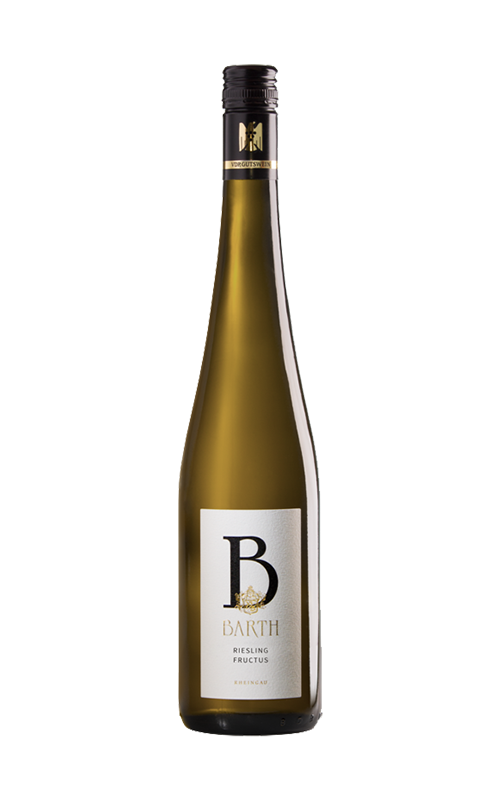
1
Barth, rheingau
Pioneers of single-vineyard Riesling Sekt, Barth love all things sparkling. Following the traditional method, these Sekt masters have spent years honing their craft and are closely involved in the VDP Sekt Statute. The Barth vineyards are eco-certified. Owners Christine and Mark Barth see themselves and their vineyard team as working hand-in-hand with nature in their journey to producingwonderful sparkling wines. Barth prides itself on combining tradition and innovation; its modern wine shop stands above a treasure trove of mature wines, a state-of-the-art cellar contains old wooden barrels, and the latest cellar technology stands side-by-side with traditional riddling pupitres. Barth joined the VDP in 1999 and produces 135,000 bottles annually.
2022 Pinot Noir Rosé Trocken
Mineral-rich, firm, and slightly floral-raspberry, this wine tempts you to dream in the sun (if you’re not already there). Grapefruit freshness gives even more lightness. This is a serious rosé with a French soul. It’s a good thing that sparkling wines and still wines need different winemaking processes! Since the pressing for the rosé sparkling wine also produces part of this wine, winemaker Mark Barth leaves the grapes in contact with the must for eight to twelve hours after crushing. This is how rich color and berry aromas get into the wine. The wine is completely dry (2 grams of residual sugar) and entirely matured in stainless steel to support its taut, fresh character. With its freshness, tautness, and clear berry aromas, the 2020 Pinot Noir Rosé goes well with classic pasta dishes with light sauces like Aglio Olio or Carbonara, but also with pickled vegetables, salami, or ham.
Tasting Notes
Wine Facts
- Pinot Noir
- Dry
- VDP.GUTSWEIN
- Loess loam
- 0.75Ltr
- 5g/l
- 2g/l
- 12%
- 8-10°C
- Now
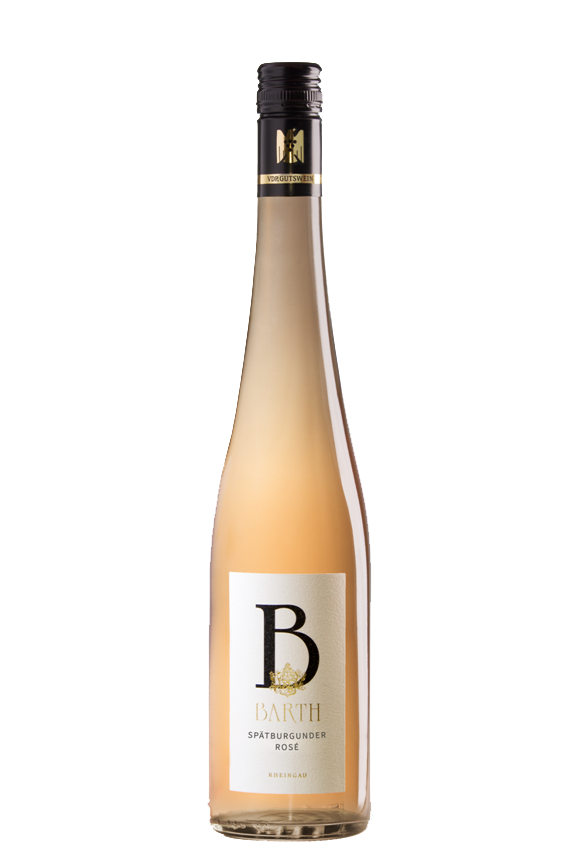
2
Barth, rheingau
Pioneers of single-vineyard Riesling Sekt, Barth love all things sparkling. Following the traditional method, these Sekt masters have spent years honing their craft and are closely involved in the VDP Sekt Statute. The Barth vineyards are eco-certified. Owners Christine and Mark Barth see themselves and their vineyard team as working hand-in-hand with nature in their journey to producingwonderful sparkling wines. Barth prides itself on combining tradition and innovation; its modern wine shop stands above a treasure trove of mature wines, a state-of-the-art cellar contains old wooden barrels, and the latest cellar technology stands side-by-side with traditional riddling pupitres. Barth joined the VDP in 1999 and produces 135,000 bottles annually.
2015 Sekt Ultra Pinot Brut Nature
The ULTRA Brut Nature is the winery’s flagship sparkling wine. It’s balanced with tightly woven aromas from apple peel to gooseberries, plus red fruit and creamy notes. Lifted by the spiciness of the lees, where it’s allowed to rest longer than any other BARTH sparkling wine, it has a firm presence in the glass with a long, fine perlage. The base wine, a Pinot Noir Blanc de Noir, comes from the 2014 vintage. Prepared with traditional bottle fermentation, this Brut Nature lies on lees for 72 months before it’s riddled by hand, disgorged, a process that it not followed with dosage. This long lees maturation gives it fullness, a fine yeasty flavor, and phenolic contours. It was matured in large oak barrels to give it additional richness and weight. With its power and intensity, the ULTRA Brut Nature pairs well with tangy, flavorful dishes like Vitello Tonnato, for example, but also rich Saltimbocca or a Cordon Bleu recipes.
Tasting Notes
Wine Facts
- Pinot Noir
- Dry
- VDP.Gutssekt
- Loess loam
- 0.75Ltr
- 5g/l
- 1.1g/l
- 12%
- 6-8°C
- Now-2030
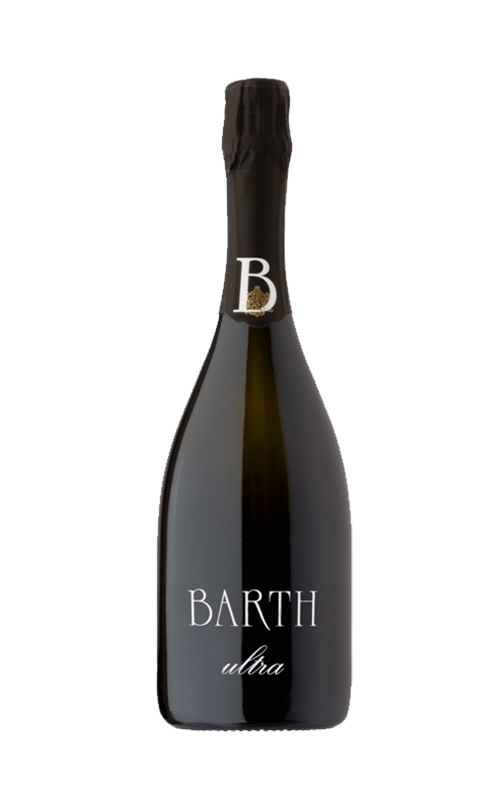
3
Barth, rheingau
Pioneers of single-vineyard Riesling Sekt, Barth love all things sparkling. Following the traditional method, these Sekt masters have spent years honing their craft and are closely involved in the VDP Sekt Statute. The Barth vineyards are eco-certified. Owners Christine and Mark Barth see themselves and their vineyard team as working hand-in-hand with nature in their journey to producingwonderful sparkling wines. Barth prides itself on combining tradition and innovation; its modern wine shop stands above a treasure trove of mature wines, a state-of-the-art cellar contains old wooden barrels, and the latest cellar technology stands side-by-side with traditional riddling pupitres. Barth joined the VDP in 1999 and produces 135,000 bottles annually.
2016 Sekt Hassel Riesling Brut Nature
A stone fruit potpourri from ripe peaches to apricot jam vibrates between nose and palate. In addition, nutty notes, the fine strength of black tea, and some lees notes make this a very expressive bubbly. The HASSEL RIESLING Brut Nature VDP.GROSSE LAGE® belongs in the top league of the already rare single-vineyard sparkling wines in Germany. Riesling vines grow in the Grand Cru location (also VDP.GROSSE LAGE®) HASSEL, one of the best vineyards in the Rheingau. Loess loam soil, a southern aspect, and moderate steepness enrich this sparkling wine with a unique character. The base wines are 100 percent matured in large wood barrels. The sparkling wine, prepared using traditional bottle fermentation, then lies on the lees for 60 months until it is hand-riddled and disgorged. With its fruit, strength, and intensity, it pairs perfectly with grilled tuna or also slightly bitter flavors found in asparagus or artichokes. It also matches spicy Asian food.
Tasting Notes
Wine Facts
- Riesling
- Dry
- VDP.GROSSE LAGE
- Hattenheim Hassel
- South
- Steep Vineyards
- Loess loam
- 0.75Ltr
- 5g/l
- 2.4g/l
- 12.5%
- 6-8°C
- Now-2030
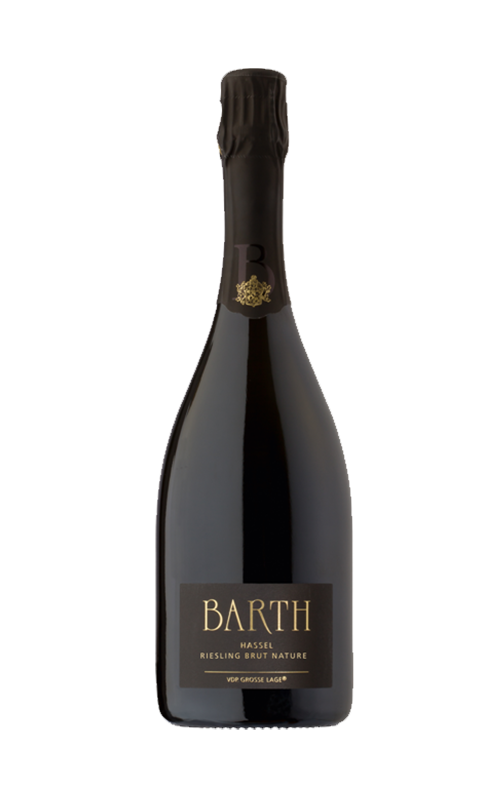
4
Battenfeld-Spanier, rheinhessen
The dynamic husband-wife team of H. O. Spanier and CarolinSpanier-Gillot is the driving force behind the Battenfeld Spanier Estate. The Magic is hidden deep beneath the soil of this outstanding winery located in Rheinhessen, namely layers of lime that add precise, vibrant minerality across the spectrum of their varietals: Riesling, Spätburgunder (Pinot Noir), and Silvaner. Cellarmaster H. O. has combined the perfectionism developed during an early career in sport with the trust in nature that goes hand-in-hand with the finest wine-making. When applied to organic and bio-dynamic vineyard and winery principles this combination of skill and intuition yields wines crafted almost single-handedly by a rich and unique terroir. The result is the estate’s incomparable Silver-label Riesling and vibrant Spätburgunder and Silvaner. Battenfeld Spanier has 48,000 acres of holdings near Worms across from Wonnegau, Hohen-Sülzen, and the Zellertal and has been a proud member of the VDP since 2008.
2021 Hohen-Sülzen Riesling
The Erste Lage classification denotes world-class vineyards of especially notable characteristics: Hohen-Sülzen lies along the Eisbachtal. This river flows from the Donnersberg massif and exerts a significant climatic influence on the valley. The fluctuations between daytime and night-time temperature are more pronounced in Hohen-Sülzen than in other districts. This gives the wines their freshness, elegance, and tension despite the rich ripeness of the grapes. The vines grow on pure limestone with a generous deposit of loess and are characterized by their ripe fruit, fine spice, and nuanced acidity. The wine is selectively hand-harvested, wild fermented, and raised in Stück and Doppelstück barrels. Shades of pale yellow, with green hues and a silver rim show in the glass. Yellow stone fruit and spice weave an aromatic web around the nose of this Hohen-Sülzen Riesling. Peach, dried apricot, and Mirabelle plum shine, followed by dried herbs, light tobacco, laurel, and the delicate spice of mace and white pepper. A linear palate blends ripe, juicy fruit with savory spice and deep, smoky minerality. This is an unforgettable wine with delicate fruit, saline finish, and indisputable origin. Given its precise, cool, and refreshing nature, it offers countless options for pairing with fish dishes, sushi, or crisp mixed vegetables from the wok.
Tasting Notes
Wine Facts
- Riesling
- Dry
- VDP.ERSTE LAGE
- Hohen-Sülzen
- South, Southwest
- 500ft Elevation, 15% gradient
- Limestone with Loess, Loam
- 0.75Ltr
- 7g/l
- 3g/l
- 12%
- 6-8°C
- Now-2040

5
Battenfeld-Spanier, rheinhessen
The dynamic husband-wife team of H. O. Spanier and CarolinSpanier-Gillot is the driving force behind the Battenfeld Spanier Estate. The Magic is hidden deep beneath the soil of this outstanding winery located in Rheinhessen, namely layers of lime that add precise, vibrant minerality across the spectrum of their varietals: Riesling, Spätburgunder (Pinot Noir), and Silvaner. Cellarmaster H. O. has combined the perfectionism developed during an early career in sport with the trust in nature that goes hand-in-hand with the finest wine-making. When applied to organic and bio-dynamic vineyard and winery principles this combination of skill and intuition yields wines crafted almost single-handedly by a rich and unique terroir. The result is the estate’s incomparable Silver-label Riesling and vibrant Spätburgunder and Silvaner. Battenfeld Spanier has 48,000 acres of holdings near Worms across from Wonnegau, Hohen-Sülzen, and the Zellertal and has been a proud member of the VDP since 2008.
2021 Frauenberg Riesling
The Frauenberg lies in the southern Wonnegau, north of Hohen-Sülzen heading towards Flörsheim at an elevation of up to 280 meters and up to 40% gradient. The historic site can be traced back through official documents to at least 1290, where it was called the “an frauwenhalten” and was the site of a nunnery. H.O. Spanier rescued the Frauenberg from oblivion and placed it back in the consciousness of wine lovers. While purely south facing, the exposed site on the Frauenberg experiences constant cooling winds, with a broken limestone top layer and a base substrate of solid limestone. The vines dig deep into the hard, mineral-rich soil. This lends them a self-sustaining character and allows for long, healthy vegetative periods, even in extreme years. Wines from the Frauenberg are meticulously hand-selected and harvested, wild fermented and matured in Stück and Doppelstück barrels. Bright straw-yellow, it has shimmering hues and a silver rim. In its youth, Frauenberg is more of a sketch than a highly shaded and detailed self-portrait. Stony and austere, it is reminiscent of wet gravel while cooling notes of fresh chervil and cucumber peel complement the citrus fruit, apricot stone, and apple skin. Unmistakable dark aromatics and smoky overtones deliberately shape the precise outline. A pulsating pressure builds on the tense palate, even as the nearly orchestral acidity acts like a conductor, guiding extract, phenolics, and minerality to each play their part. Complex and nuanced, it is a wine whose potential requires not only a decanter but also a few years of bottle maturation. Frauenberg is a mineral-driven wine with a tremendous affinity for fine cuisine. Lobster, seafood, sashimi, and dishes that feature soy sauce make for great pairings, while finely-prepared German classics like KönigsbergerKlopse and Braten in horseradish sauce push it toward the sublime.
Tasting Notes
Wine Facts
- Riesling
- VDP.GROSSE LAGE
- Frauenberg
- South, Southwest
- 1200ft Elevation, 10% gradient
- Loess, Limestone, Stomy Clay Loam
- 0.75Ltr
- 7.2g/l
- 3g/l
- 12.5%
- 6-8°C
- Now-2040

6
Battenfeld-Spanier, rheinhessen
The dynamic husband-wife team of H. O. Spanier and CarolinSpanier-Gillot is the driving force behind the Battenfeld Spanier Estate. The Magic is hidden deep beneath the soil of this outstanding winery located in Rheinhessen, namely layers of lime that add precise, vibrant minerality across the spectrum of their varietals: Riesling, Spätburgunder (Pinot Noir), and Silvaner. Cellarmaster H. O. has combined the perfectionism developed during an early career in sport with the trust in nature that goes hand-in-hand with the finest wine-making. When applied to organic and bio-dynamic vineyard and winery principles this combination of skill and intuition yields wines crafted almost single-handedly by a rich and unique terroir. The result is the estate’s incomparable Silver-label Riesling and vibrant Spätburgunder and Silvaner. Battenfeld Spanier has 48,000 acres of holdings near Worms across from Wonnegau, Hohen-Sülzen, and the Zellertal and has been a proud member of the VDP since 2008.
2020-Frauenberg Riesling
The Frauenberg lies in the southern Wonnegau, north of Hohen-Sülzen heading towards Flörsheim at an elevation of up to 280 meters and up to 40% gradient. The historic site can be traced back through official documents to at least 1290, where it was called the “an frauwenhalten” and was the site of a nunnery. H.O. Spanier rescued the Frauenberg from oblivion and placed it back in the consciousness of wine lovers. While purely south facing, the exposed site on the Frauenberg experiences constant cooling winds, with a broken limestone top layer and a base substrate of solid limestone. The vines dig deep into the hard, mineral-rich soil. This lends them a self-sustaining character and allows for long, healthy vegetative periods, even in extreme years. Wines from the Frauenberg are meticulously hand-selected and harvested, wild fermented and matured in Stück and Doppelstück barrels. Bright straw-yellow, it has shimmering hues and a silver rim. In its youth, Frauenberg is more of a sketch than a highly shaded and detailed self-portrait. Stony and austere, it is reminiscent of wet gravel while cooling notes of fresh chervil and cucumber peel complement the citrus fruit, apricot stone, and apple skin. Unmistakable dark aromatics and smoky overtones deliberately shape the precise outline. A pulsating pressure builds on the tense palate, even as the nearly orchestral acidity acts like a conductor, guiding extract, phenolics, and minerality to each play their part. Complex and nuanced, it is a wine whose potential requires not only a decanter but also a few years of bottle maturation. Frauenberg is a mineral-driven wine with a tremendous affinity for fine cuisine. Lobster, seafood, sashimi, and dishes that feature soy sauce make for great pairings, while finely-prepared German classics like KönigsbergerKlopse and Braten in horseradish sauce push it toward the sublime.
Tasting Notes
Wine Facts
- Riesling
- VDP.GROSSE LAGE
- Frauenberg
- South, Southwest
- 1200ft Elevation, 10% gradient
- Loess, Limestone, Stomy Clay Loam
- 0.75Ltr
- 7.2g/l
- 3g/l
- 12.5%
- 6-8°C
- Now-2040

7
Battenfeld-Spanier, rheinhessen
The dynamic husband-wife team of H. O. Spanier and CarolinSpanier-Gillot is the driving force behind the Battenfeld Spanier Estate. The Magic is hidden deep beneath the soil of this outstanding winery located in Rheinhessen, namely layers of lime that add precise, vibrant minerality across the spectrum of their varietals: Riesling, Spätburgunder (Pinot Noir), and Silvaner. Cellarmaster H. O. has combined the perfectionism developed during an early career in sport with the trust in nature that goes hand-in-hand with the finest wine-making. When applied to organic and bio-dynamic vineyard and winery principles this combination of skill and intuition yields wines crafted almost single-handedly by a rich and unique terroir. The result is the estate’s incomparable Silver-label Riesling and vibrant Spätburgunder and Silvaner. Battenfeld Spanier has 48,000 acres of holdings near Worms across from Wonnegau, Hohen-Sülzen, and the Zellertal and has been a proud member of the VDP since 2008.
2021 Kirchenstück Riesling
The Kirchenstück is mentioned by name in official documents predating the Thirty Years War. Situated at an elevation of 150 meters on a plateau between two churches, it overlooks H.O.’s hometown of Hohen-Sülzen. Its ancient centerpiece is home to his oldest vineyards, planted in the 1960s. Today the wines come from the best parcels of the entire Kirchenstück — average vine age: 35 years — for wines of notable fruit and depth. The soft, calcareous stone of the upper soil provides an excellent nutritional supply despite an extremely calcareous substrate. Characterized by its expressive fruit, the Kirchenstück is accessible starting in youth, yet promises immense development potential over time. Wines from the Kirchenstück are meticulously hand selected, wild fermented and matured in Stück and Doppelstück barrels. The wine shimmers in shades of pale straw yellow, shifting and changing in the large bowled glass to reveal a nose of juicy fruit and the captivating herbal spice of water mint, lemon-thyme and savory. The green herbal spice is then underscored with yellow and red fruit aromas. Notes of fully ripe yellow apple and quince as well as nectarine are underpinned by accents of wet chalk. Concentrated fruit with a mouthwatering, fine-grained phenolic comes alive to a youthful, electric nerve of acidity. Complex and deep, the wine moves with enviable confidence and focus across the palate and toward its steadfast and salty mineral finish. The Kirchenstück is notably openspirited in its youth, yet don’t sleep on its enormous maturation ceiling and well-deserved claim as an accompaniment to fine cuisine: North African or Levant cooking are ideal pairings, as are fish and seafood classics from the French tradition.
Tasting Notes
Wine Facts
- Riesling
- Dry
- VDP.GROSSE LAGE
- Kirchenstück
- South
- Soft Elevation, 15% gradient
- Limestone, Loamy Loess
- 0.75Ltr
- 8.5g/l
- 0.3g/l
- 12.5%
- 6-8°C
- Now-2045

8
Battenfeld-Spanier, rheinhessen
The dynamic husband-wife team of H. O. Spanier and CarolinSpanier-Gillot is the driving force behind the Battenfeld Spanier Estate. The Magic is hidden deep beneath the soil of this outstanding winery located in Rheinhessen, namely layers of lime that add precise, vibrant minerality across the spectrum of their varietals: Riesling, Spätburgunder (Pinot Noir), and Silvaner. Cellarmaster H. O. has combined the perfectionism developed during an early career in sport with the trust in nature that goes hand-in-hand with the finest wine-making. When applied to organic and bio-dynamic vineyard and winery principles this combination of skill and intuition yields wines crafted almost single-handedly by a rich and unique terroir. The result is the estate’s incomparable Silver-label Riesling and vibrant Spätburgunder and Silvaner. Battenfeld Spanier has 48,000 acres of holdings near Worms across from Wonnegau, Hohen-Sülzen, and the Zellertal and has been a proud member of the VDP since 2008.
2021 Zeller Kreuzberg Riesling Pfalz
The Zellertal has seen winegrowing since the 8th century, placing it squarely among the oldest winegrowing regions anywhere in Germany. Nevertheless, it was all but forgotten in the 20th century until H.O. Spanier chose it, after the Frauenberg and Schwarzer Herrgott, as his next project to restore to the consciousness of wine lovers. The Kreuzberg lies just below the Schwarzer Herrgott and in fact looks up to the Herrgott’s black Kreuz (‘cross’), earning it the name "Zellertal Kreuzberg." Geologically, the Zellertal Kreuzberg is just as unique as the Schwarzer Herrgott, standing on a massive bank of limestone running from Rheinhessen’s Frauenberg into the Pfalz portion of the Zellertal and known for producing wines of an incredibly mineral character. The Kreuzberg Riesling has been classified as a GG since the 2020 vintage, thus making it the first Großes Gewächs from the Pfalz in our portfolio. Hand harvested and wild fermented, the Kreuzberg Riesling is raised in traditional Halbstück barrels and matured on the fine lees until the summer after harvest. The wine winks with shades of pale straw in the glass, and soon overcomes its initial hesitation to reveal that it is anything but reliant on primary fruits. It is notably stony and austere, with salty aromas redolent of a refreshing sea breeze and underscored with aromas of sage and goutweed. Refined and complex, the palate balances an concentrated extracts and reductive fruit against a notably salty soul. Using the tremendous tension and momentum, it blends finesse and elegance with the distinctive minerality of the Zellertal’s limestone soils. A clear occasion to bring out the big glasses, to best enjoy its tremendous development potential. The 2021 Zeller Kreuzberg Riesling GG is exclusively being offered at the VDP.AUCTIONS in Bad Kreuznach.
Tasting Notes
Wine Facts
- Riesling
- Dry
- VDP.GROSSE LAGE
- Kreuzberg
- South
- Soft Elevation, 15% gradient
- Limestone, Loamy Loess
- 0.75Ltr
- 8.0g/l
- 0.3g/l
- 12.5%
- 6-8°C
- Now-2045

9
Battenfeld-Spanier, rheinhessen
The dynamic husband-wife team of H. O. Spanier and CarolinSpanier-Gillot is the driving force behind the Battenfeld Spanier Estate. The Magic is hidden deep beneath the soil of this outstanding winery located in Rheinhessen, namely layers of lime that add precise, vibrant minerality across the spectrum of their varietals: Riesling, Spätburgunder (Pinot Noir), and Silvaner. Cellarmaster H. O. has combined the perfectionism developed during an early career in sport with the trust in nature that goes hand-in-hand with the finest wine-making. When applied to organic and bio-dynamic vineyard and winery principles this combination of skill and intuition yields wines crafted almost single-handedly by a rich and unique terroir. The result is the estate’s incomparable Silver-label Riesling and vibrant Spätburgunder and Silvaner. Battenfeld Spanier has 48,000 acres of holdings near Worms across from Wonnegau, Hohen-Sülzen, and the Zellertal and has been a proud member of the VDP since 2008.
2021 Grüner Sylvaner Trocken
Although considered a native of Franken, Grüner Sylvaner also looks back on a long tradition in the Wonnegau, and could well be the original rootstock of Rheinhessen. When grown on calcareous soils around Hohen-Sülzen, it perpetually develops a certain herbal spice. Grüner Sylvaner is raised in steel and wild fermented to be bone dry. The wine graces the glass in shades of pale yellow with green hues: Yellow fruit aromas, with notes of nectarine and small yellow pear, are balanced with spring kitchen herbs. The crystalline palate is linear and precise, with everything in the right place: the fruit is flanked by a drying texture, with mild and perfectly integrated acidity. Our Grüner Sylvaner is an ace up the sleeve for a colorful range of vegetable dishes, pairing deftly with salads and light dishes just as well as hearty ones such as a classic German Wurstsalat.
Tasting Notes
Wine Facts
- Grüner Sylvaner
- Dry
- ORTSWEIN
- Limestone, Loamy Loess
- 0.75Ltr
- 6.5g/l
- 0.3g/l
- 12 %
- 6-8°C
- Now-2045

10
Battenfeld-Spanier, rheinhessen
The dynamic husband-wife team of H. O. Spanier and CarolinSpanier-Gillot is the driving force behind the Battenfeld Spanier Estate. The Magic is hidden deep beneath the soil of this outstanding winery located in Rheinhessen, namely layers of lime that add precise, vibrant minerality across the spectrum of their varietals: Riesling, Spätburgunder (Pinot Noir), and Silvaner. Cellarmaster H. O. has combined the perfectionism developed during an early career in sport with the trust in nature that goes hand-in-hand with the finest wine-making. When applied to organic and bio-dynamic vineyard and winery principles this combination of skill and intuition yields wines crafted almost single-handedly by a rich and unique terroir. The result is the estate’s incomparable Silver-label Riesling and vibrant Spätburgunder and Silvaner. Battenfeld Spanier has 48,000 acres of holdings near Worms across from Wonnegau, Hohen-Sülzen, and the Zellertal and has been a proud member of the VDP since 2008.
2020 Spätburgunder
The southern Wonnegau has been known since medieval times for achieving ripeness in grape varieties that fail to thrive in cooler places. Spätburgunder has always been part of that equation, and can virtually be counted as a native of this place. While days in the Wonnegau can be very hot, the cool nights mean overall higher diurnal temperature swings than in other districts. Harvested ripe — but never overripe — we raise our estate-level Spätburgunder Gutswein in barrique and French tonneaux. This provides the first encounter between wine and oxygen, accentuating the delicate fruit of the Spätburgunder with earthy spice. The wine shines a deep ruby red in the glass with aromas of red berry fruit and ripe cherries. Underscored with delicate herbal nuances, it is juicy and refreshing with charming fruit, subtle spice, and refined tannins that give it a thrilling texture. From a wurst sandwich to pasta, an uncomplicated, joyous Spätburgunder complements any day or dish.
Tasting Notes
Wine Facts
- Pinot Noir
- Dry
- VDP.GUTSWEIN
- Limestone and Loess
- 0.75Ltr
- 5.5g/l
- 0.3g/l
- 12.5%
- 17-19°C
- Now-2040

11
Battenfeld-Spanier, rheinhessen
The dynamic husband-wife team of H. O. Spanier and CarolinSpanier-Gillot is the driving force behind the Battenfeld Spanier Estate. The Magic is hidden deep beneath the soil of this outstanding winery located in Rheinhessen, namely layers of lime that add precise, vibrant minerality across the spectrum of their varietals: Riesling, Spätburgunder (Pinot Noir), and Silvaner. Cellarmaster H. O. has combined the perfectionism developed during an early career in sport with the trust in nature that goes hand-in-hand with the finest wine-making. When applied to organic and bio-dynamic vineyard and winery principles this combination of skill and intuition yields wines crafted almost single-handedly by a rich and unique terroir. The result is the estate’s incomparable Silver-label Riesling and vibrant Spätburgunder and Silvaner. Battenfeld Spanier has 48,000 acres of holdings near Worms across from Wonnegau, Hohen-Sülzen, and the Zellertal and has been a proud member of the VDP since 2008.
2019 Hohen-Sülzen Spätburgunder
The Erste Lage classification denotes world-class vineyards of especially notable characteristics: Hohen-Sülzen lies along the Eisbachtal. This river flows from the Donnersberg massif and exerts a significant climatic influence on the valley. The fluctuations between daytime and night-time temperature are more pronounced in Hohen-Sülzen than in other districts. This gives the wine its freshness, elegance, and tension. The vines grow on pure limestone with a generous deposit of loess and are characterized by their ripe fruit, fine spice, and nuanced acidity. The grapes for this wine were selectively hand-harvested, wild fermented, and matured for 18 months in French barriques. With shades of deep ruby, Hohen-Sülzen Spätburgunder reveals aromas of dark berries such as blackberry and elderberry. The sublime touch of barrel spice complements the fruit, with mild accents of allspice and nutmeg. It's chiseled and elegant on the palate, with generous dark fruit and youthful, polished tannins. A delicate salty minerality and striking verve carry the fruit across the spicy-cool finish line. A delightful pairing with Boeuf Bourgignon, roasted pigeon, or Sicilian parmigiana.
Tasting Notes
Wine Facts
- Pinot Noir
- Dry
- VDP.ERSTE LAGE
- Hohen-Sülzen
- South, Southwest
- 500ft Elevation, 15% gradient
- Limestone and Loess
- 0.75Ltr
- 5.8g/l
- 0.3g/l
- 12.5%
- 17-19°C
- Now-2040

12
Battenfeld-Spanier, rheinhessen
The dynamic husband-wife team of H. O. Spanier and CarolinSpanier-Gillot is the driving force behind the Battenfeld Spanier Estate. The Magic is hidden deep beneath the soil of this outstanding winery located in Rheinhessen, namely layers of lime that add precise, vibrant minerality across the spectrum of their varietals: Riesling, Spätburgunder (Pinot Noir), and Silvaner. Cellarmaster H. O. has combined the perfectionism developed during an early career in sport with the trust in nature that goes hand-in-hand with the finest wine-making. When applied to organic and bio-dynamic vineyard and winery principles this combination of skill and intuition yields wines crafted almost single-handedly by a rich and unique terroir. The result is the estate’s incomparable Silver-label Riesling and vibrant Spätburgunder and Silvaner. Battenfeld Spanier has 48,000 acres of holdings near Worms across from Wonnegau, Hohen-Sülzen, and the Zellertal and has been a proud member of the VDP since 2008.
2020 Kirchenstück Spätburgunder
The Kirchenstück is our flagship in Hohen-Sülzen. It is a very old vineyard, which is already mentioned in documents before the 30-year war. Its original name was Griebelsteyn-and this vociferous name is very apt. Kirchenstück consists of soft, limestone stones and daytime temperatures are always a little higher than in our locations in Mölsheim or Nieder-Flörsheim. Hohen-Sülzen lies in the Eisbach Valley where, as the name suggests, the cold stream, which originates in the Donnersberg massif, exerts a considerable influence with cooler nights. As a result, despite the high grape ripeness, the wines retain their freshness, elegance, and acidity. This Spätburgunder comes from our oldest Pinot Noir vines. The yields are extremely low and the chalky underfloor brings a wonderfully cool freshness to the wine. The dark fruit aromas of currant and black cherry are restrained. In the mouth, the wine remains dark and spicy, and minerality dominates. This Spätburgunder matured in one-year-old barrels from Burgundy for almost two years.
Tasting Notes
Wine Facts
- Pinot Noir
- Dry
- VDP.GROSSE LAGE
- Kirchenstück
- South
- Soft Elevation, 15% gradient
- Limestone, Loamy Loess
- 0.75Ltr
- 5.7g/l
- 0.3g/l
- 13.5%
- 17-19°C
- Now-2045

13
Battenfeld-Spanier, rheinhessen
The dynamic husband-wife team of H. O. Spanier and CarolinSpanier-Gillot is the driving force behind the Battenfeld Spanier Estate. The Magic is hidden deep beneath the soil of this outstanding winery located in Rheinhessen, namely layers of lime that add precise, vibrant minerality across the spectrum of their varietals: Riesling, Spätburgunder (Pinot Noir), and Silvaner. Cellarmaster H. O. has combined the perfectionism developed during an early career in sport with the trust in nature that goes hand-in-hand with the finest wine-making. When applied to organic and bio-dynamic vineyard and winery principles this combination of skill and intuition yields wines crafted almost single-handedly by a rich and unique terroir. The result is the estate’s incomparable Silver-label Riesling and vibrant Spätburgunder and Silvaner. Battenfeld Spanier has 48,000 acres of holdings near Worms across from Wonnegau, Hohen-Sülzen, and the Zellertal and has been a proud member of the VDP since 2008.
2012 Blanc De Blancs Prestige
Battenfeld Spanier Blanc de Blancs Sekt Prestige is made from our plots of Chardonnay located in Hohen-Sülzen. The climate here is perfect to grow Chardonnay in a very fresh and elegant style. First to be harvested, these grapes have to remain low in sugar and high in acidity in order to evolve nicely along the years. The whole bunches are gently pressed in order to start the vinification of this premium traditional method. The juice is then fermented in French oak tonneaux (second & third use) and stay until June on its fine lees. After racking the wine, it is bottled with a capsule in order to start the second fermentation. Finally, after 9 years on its lees, our Blanc de Blancs Sekt Prestige 2012 was disgorged. The 2012 vintage is firm and deep. It shows yeasty character traduced by a nutty, citric tart and brioche aroma, along with delicate floral and stone fruit nuances. The flavours are clear and the wine is dry. Despite a long time on the lees, it is juicy with ripe and dry fruits, creamy and smoky taste. Let it breathe to show complex flavours of candy, patisserie and a finely spicy finish
Tasting Notes
Wine Facts
- Chardonnay
- Dry
- VDP.GROSSE LAGE
- Limestone, Loamy Loess
- 0.75Ltr
- 5.7g/l
- 0.3g/l
- 13.5%
- 6-8°C
- Now-2045

14
Blankenhorn, baden
At Blankenhorn, owner Martin Männer and cellar master Yvonne Männer are the kinds of perfectionists that German wine lovers adore: they’re obsessed in all the right ways with making sure each of their Baden wines has the right amount of time to mature in bottle before release. Not only time matters but also the vessel which is why this tight-knit family team uses large barrels holding up to 3,000 liters. The finished product is elegant wine all the more refined for being crafted from fruit that grows in certified sustainable vineyards. While Blankenhorn regards Gutedel as a great intro to its impressive portfolio, it also recommends its 2016 Sonnenstück Chardonnay GG and is proud of all its range from its Spätburgunder to its international varietals. A VDP member since 1987, Martin and Yvonne work across 24,00 acres of clay-rich terroir in their 19th-century winery.
2020 Schliengen Chasselas Le Clocher
This wine displays a fine, elegant structure. A perfect combination of light fruits and an invigorating acidity, it undergoes spontaneous fermentation, with at least 10 months storage in barrels on lees. Part malolactic fermentation adds body and richness. Ideal pairing dishes include zucchini and tomato casserole and cauliflower casserole coated in nuts.
Tasting Notes
Wine Facts
- Chasselas
- Dry
- VDP.ERSTE LAGE
- Schliengen
- Limestone and loess
- 0.75Ltr
- 6.7g/l
- 3.9g/l
- 12.7%
- 8-9°C
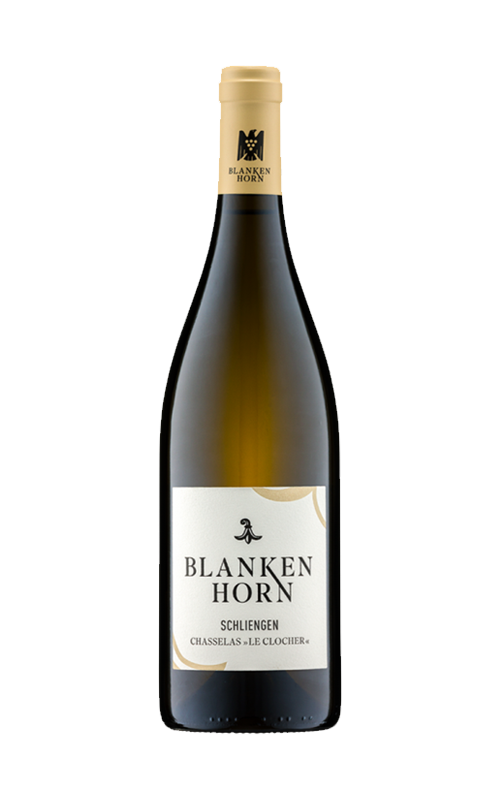
15
Bürgerspital, franken
A founding member of the VDP, Bürgerspital in Würzburg is a Franken estate with more than 700 years of vinicultural tradition under its belt. Robert Haller is at the helm, leading a winery that cultivates Silvaner and Riesling on shell-limestone terroir. Always striving for an expression of place, Haller says minerality, complexity, and finesse are more valuable to Bürgerspital than fruitiness, sweetness, or opulence. The wines follow their own path, and the result is fine accompaniments to food – one of the cornerstones that guides work in the vineyard and the winery. Bürgerspital has been a VDP member since 1955 and produces 850,000 bottles of wine annually.
2022 Silvaner Gutswein
Short maceration, temperature-controlled fermentation and storage in stainless steel tanks. The result is a refreshing aromatic and juicy wine. The Silvaner estate wine is a versatile accompaniment to meals, especially with light dishes, asparagus, freshwater fish, poultry and cream cheese with herbs.
Tasting Notes
Wine Facts
- Silvaner
- Dry
- VDP.Gutswein
- Muschelkalk (Shell-limestone)
- 0.75Ltr
- 6.5g/l
- 3.1g/l
- 12.5%
- 10-12°C
- Now-2035
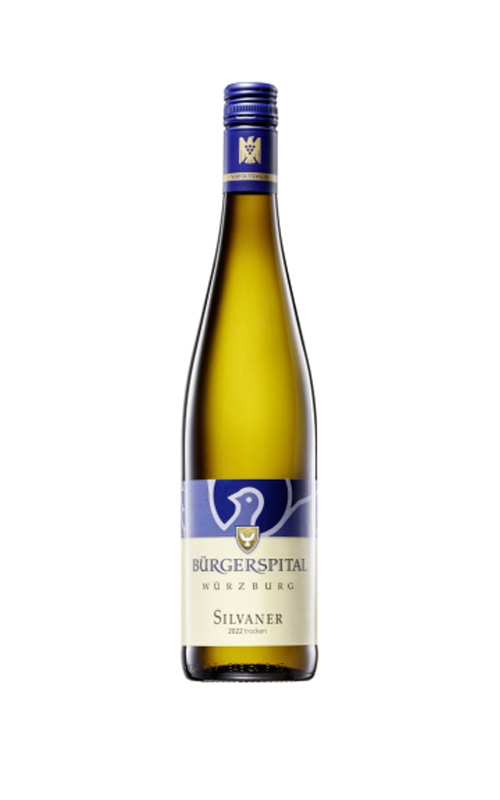
16
Bürgerspital, franken
A founding member of the VDP, Bürgerspital in Würzburg is a Franken estate with more than 700 years of vinicultural tradition under its belt. Robert Haller is at the helm, leading a winery that cultivates Silvaner and Riesling on shell-limestone terroir. Always striving for an expression of place, Haller says minerality, complexity, and finesse are more valuable to Bürgerspital than fruitiness, sweetness, or opulence. The wines follow their own path, and the result is fine accompaniments to food – one of the cornerstones that guides work in the vineyard and the winery. Bürgerspital has been a VDP member since 1955 and produces 850,000 bottles of wine annually.
2022 Würzburger Pfaffenberg Silvaner
From our oldest Silvaner vineyard (planted in 1971), this wine boasts finessed aromas of Mediterranean herbs. Made with carefully selected fruit from old vines, it’s fermented with natural yeasts and aged on lees in large oak casks. This white is delightful with dishes like roast veal or fine river fish.
Tasting Notes
Wine Facts
- Silvaner
- Dry
- VDP.ERSTE LAGE
- Würzburger Pfaffenberg
- South Space
- Steep Elevation
- Muschelkalk (Shell-limestone)
- 0.75Ltr
- 6g/l
- 2.2g/l
- 13%
- 10-12°C
- Now-2035

17
Bürgerspital, franken
A founding member of the VDP, Bürgerspital in Würzburg is a Franken estate with more than 700 years of vinicultural tradition under its belt. Robert Haller is at the helm, leading a winery that cultivates Silvaner and Riesling on shell-limestone terroir. Always striving for an expression of place, Haller says minerality, complexity, and finesse are more valuable to Bürgerspital than fruitiness, sweetness, or opulence. The wines follow their own path, and the result is fine accompaniments to food – one of the cornerstones that guides work in the vineyard and the winery. Bürgerspital has been a VDP member since 1955 and produces 850,000 bottles of wine annually.
2015 Würzburger Stein Silvaner GG
This GG Silvaner displays a fine, complex structure, excellent maturity, fine fruit, and classic “Stein Wein” character and minerality. Careful hand selection of fruit that’s fermented with natural yeasts and aged on lees in large oak casks results in an elegant white. This wine’s ideal pairing for rich fish dishes, white meat, or poultry.
Tasting Notes
Wine Facts
- Silvaner
- Dry
- VDP.GROSSE LAGE
- WürzburgerStein GG
- South
- 800ft Elevation, 30-80% gradient
- Muschelkalk (Shell-limestone)
- 0.75Ltr
- 7.2g/l
- 3.5g/l
- 13.5%
- 10-12°C
- Now-2045
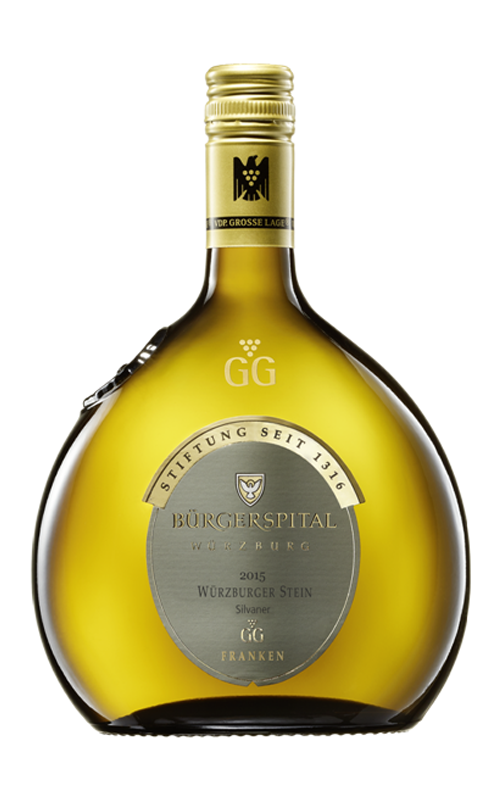
18
Bürgerspital, franken
A founding member of the VDP, Bürgerspital in Würzburg is a Franken estate with more than 700 years of vinicultural tradition under its belt. Robert Haller is at the helm, leading a winery that cultivates Silvaner and Riesling on shell-limestone terroir. Always striving for an expression of place, Haller says minerality, complexity, and finesse are more valuable to Bürgerspital than fruitiness, sweetness, or opulence. The wines follow their own path, and the result is fine accompaniments to food – one of the cornerstones that guides work in the vineyard and the winery. Bürgerspital has been a VDP member since 1955 and produces 850,000 bottles of wine annually.
2020 Würzburger Rieslaner
Rieslaner is a new cross between Riesling and Silvaner dating back to 1921 and grown in Franken and some vineyards in the Pfalz. It displays aromas of mandarin orange and delicate fruit in a fine structure with a long finish. Careful selection of fruit that’s fermented with natural yeasts in aged in stainless steel tanks results in a fresh white. This is ideal as an aperitif, or paired with rich meat terrines and very spicy Asian dishes, especially with chilli, ginger, or curry.
Tasting Notes
Wine Facts
- Rieslaner
- Sweet
- VDP.ORTSWEIN
- Muschelkalk (Shell-limestone)
- 0.75Ltr
- 8g/l
- 121.4g/l
- 7.5%
- 10-12°C
- Now-2045
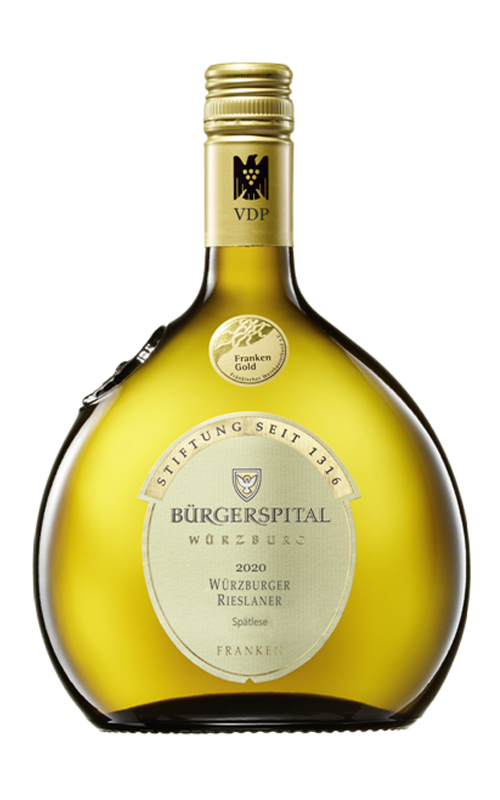
19
Castell, franken
There are not many wineries in the world that can trace the owner’s roots in the area back to 1057, but Castell can proudly make that claim. With the first mention of vineyards dating back to 1224 and with documented plantings dating to 1266, Castell has been at the forefront of winemaking in Franken for over 745 years. Castell planted the first Silvaner “Austrian” cuttings in 1659. The approach of using the unique terroir of their 175 acres creates a portfolio of Silvaner wines unparalleled across the wine world. Key to this diversity are the site-specific plantings which highlight the complexity and age-worthiness of this most versatile of grapes. Castell delayed their harvests to enhance the development and complexity of their wines. The results are seven distinct and classified vineyards which include: – Casteller Schlossberg, a VDP.Grosse Lage, – four VDP.ErsteLagen, Hohnart, Kugelspiel, Trautberg and Reitsteig which are also solely estate owned – two shared VDP.ErsteLagen, Kirchberg and Bausch. As if these vineyards with their site-specific plantings and farming were not enough to differentiate their bottlings, Castell goes the extra step of curating their barrels from oak trees in the forests surrounding the village of Castell. In short, Castell has created an ecosystem, from vineyard to barrel, focused on the same terroir throughout. The resulting wines mirror this terroir-centric philosophy and may just be the purest expression of Silvaner available today!
2017 6. Apriles Anno 1659 Silvaner
The name honors the date of the first Silvaner planting in Franken. Shades of pale gold glimmer in the glass as enchanting to the eye as the complex aromas are to the nose; a rich range of ripe yellow pear, peach, baked lemons and candied ginger peel together with the roasty, toasty notes of barrel aging. Creamy on the dry palate with a racy acidity and equal parts momentum and concentration. Beneath the barrel influence lies the classic Silvaner complexity and depth marked with plenty of curves and contours. A wine that rewards a bit of patience, and a large-bowled glass. Drink 2023 - 2033 The complexity will reward a pairing of savory mushrooms dishes, hearty venison medallions with fruit sauce; anything with figs or a finely spiced potato gratin.
Tasting Notes
Wine Facts
- Silvaner
- Dry
- VDP.ORTSWEIN
- Gipskeuper (Gypsum keuper)
- 0.75Ltr
- 7.2g/l
- 3.5g/l
- 13.5%
- 10-12°C
- Now-2045
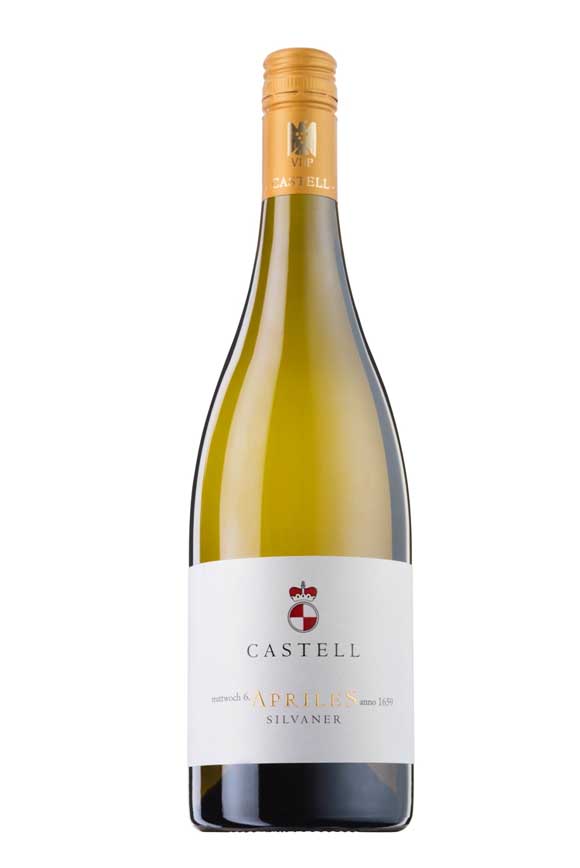
20
Freiherr Von Gleichenstein, baden
Johannes von Gleichenstein and his wife Christina von Gleichenstein are the eleventh generation who currently run the historic family winery in Oberrotweil in the middle of the Kaiserstuhl. Like their ancestors, they fell in love with wine and feel a great connection to the region. With the name Freiherr von Gleichenstein, they stand for the quality of the first-class wines, which are known far beyond the borders of the southern Baden region. They see it as their obligation to continue the long family history with commitment, professionalism, and soul. The history of the Freiherr von Gleichenstein winery dates back to 1490. At that time, the St. Blasien monastery was planning to build a tithe cellar and barn. However, it was another 15 years before the estate could be put into operation because wood had to be used for the construction. According to the traditions of the time, this had to be beaten, floated, and smoked during the waning moon and stored dry for ten years. To this day, Johannes and Christina have been able to keep many of these elaborately prepared wooden structures, as well as the wine cellar, in their original condition. The farm has been family-owned since 1634. Baron Hans Joachim von Gleichenstein converted what was then a mixed farm into a dedicated winery.
2021 Pinot Gris Gutswein trocken
This refreshing Pinot Gris has fruity aromas of ripe sugar melons, sweet pears and plum mash, especially on the nose. This is complemented by a smooth, round mouthfeel and a distinctive minerality. A pleasantly stimulating bitter note remains in the finish. It is an uncomplicated wine that brings carefree drinking pleasure with it. Immediately after the harvest, the grapes for the Pinot Gris are gently filled into the press via conveyor belts without destemming or crushing. Due to the long pressing time of 6-8 hours, important ingredients are dissolved in the juice without putting too much strain on the berries. After the must pre-clarification by sedimentation, partial batches of the must are fermented spontaneously. The wines remain on the lees for a period of 3-5 months in order to achieve a harmonious wine structure. Slightly chilled, suitable for Vespers with veal pie and farmer's bread as well as grilled meat.
Tasting Notes
Wine Facts
- Pinot Gris
- Dry
- Gutswein
- Volcanic Loess loam
- 0.75Ltr
- 7.5g/l
- 1.5g/l
- 12.5%
- 7-10°C
- Now-2025
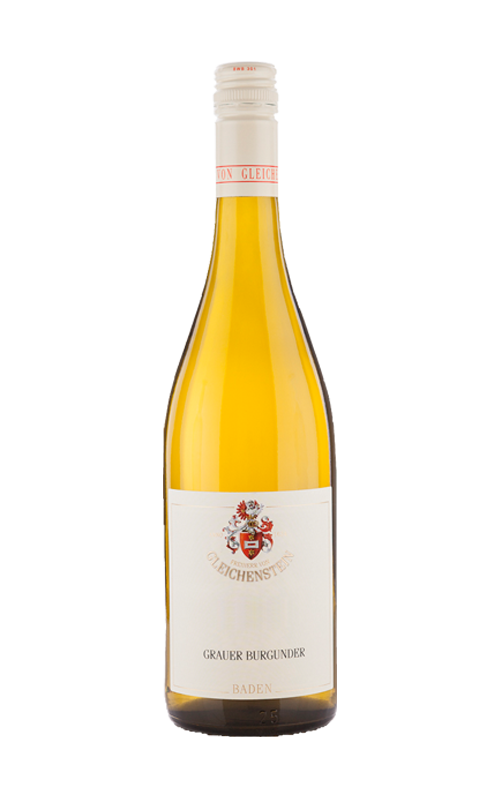
21
Freiherr Von Gleichenstein, baden
Johannes von Gleichenstein and his wife Christina von Gleichenstein are the eleventh generation who currently run the historic family winery in Oberrotweil in the middle of the Kaiserstuhl. Like their ancestors, they fell in love with wine and feel a great connection to the region. With the name Freiherr von Gleichenstein, they stand for the quality of the first-class wines, which are known far beyond the borders of the southern Baden region. They see it as their obligation to continue the long family history with commitment, professionalism, and soul. The history of the Freiherr von Gleichenstein winery dates back to 1490. At that time, the St. Blasien monastery was planning to build a tithe cellar and barn. However, it was another 15 years before the estate could be put into operation because wood had to be used for the construction. According to the traditions of the time, this had to be beaten, floated, and smoked during the waning moon and stored dry for ten years. To this day, Johannes and Christina have been able to keep many of these elaborately prepared wooden structures, as well as the wine cellar, in their original condition. The farm has been family-owned since 1634. Baron Hans Joachim von Gleichenstein converted what was then a mixed farm into a dedicated winery.
2018 Pinot Noir Gutswein trocken
This Pinot Noir presents itself in a beautiful garnet red with a slight water edge. Aromas of freshly mashed cherries and dark berries are recognizable in the bouquet. On the palate it is youthful with a spicy note and soft tannins. The wine has a light body with a medium length and fine acidity on the finish. This Pinot Noir "Hofgarten" is a light drinking pleasure. After selective hand picking, the grapes are destemmed and stored in mash fermentation tanks. The mash is cooled to 10 °C so that it can undergo a cold maceration for about 1 week. Due to the rising temperature, the mash then begins to ferment spontaneously. The fermentation lasts about 5 days. After that, the fermented juice stays on the mash for about a week to macerate again. Then the mash is pressed and stored for 12 months in large wooden barrels for malolactic fermentation and maturation. A good accompaniment to snacks and white meat. Slightly chilled, it also goes well with veal pie and farmer's bread as well as with grilled meat.
Tasting Notes
Wine Facts
- Pinot Noir
- Dry
- Gutswein
- Volcanic Loess loam
- 0.75Ltr
- 5.5g/l
- 0.8g/l
- 13.5%
- 15-18°C
- Now-2030
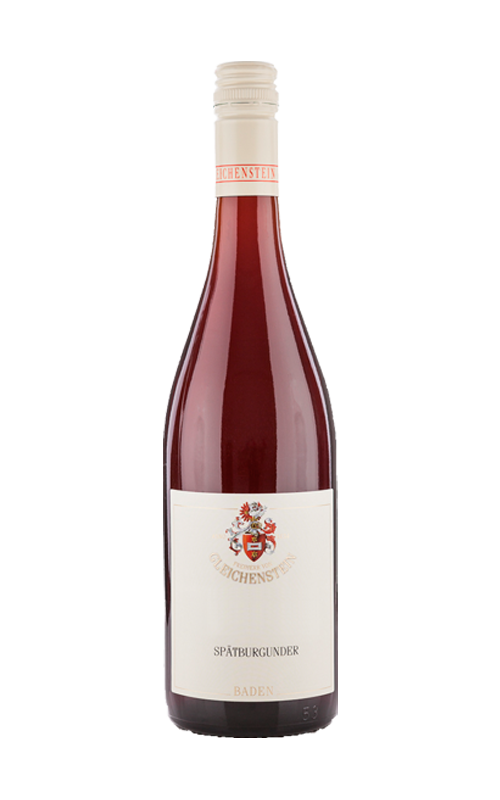
22
Fritz Waßmer, baden
In 1998, Fritz Waßmer took a lifetime of family learning and, with a passion for the vines that was second nature, started his own winery in Bad Krozingen, Baden. Proudly self-taught in the intricacies of winemaking but with generations of viticultural knowledge in his bones, Fritz built on an affinity he felt for Pinot Noir and never looked back. His love for this iconic grape, one of the star varietals of Baden, goes back a long way when Fritz started to develop an admiration for the legendary Burgundy approach to Pinot Noir production. While this is the guiding star grape at Fritz Waßmer, other classic French cultivars like Syrah, Cabernet Franc, Cabernet Sauvignon, and Merlot also have a special place in the winery vineyards. Rarities in leading German wine regions, Chardonnay, Pinot Blanc, Pinot Gris, Sauvignon Blanc, Viognier, and even Auxerrois have been added in recent years. Whether a flagship Pinot Noir or another timeless grape, Fritz’s near-obsession is to enable each unique terroir to shine through in every sip.
2020 Weisser Burgunder
Fine aromas of yellow apple and pear, floral notes, with a nice mineral finish. A soft texture and pleasant freshness without being tart. Light and fruity.
Tasting Notes
Wine Facts
- Pinot Blanc
- Dry
- Qualitätswein, Trocken
- Volcanic Soil
- 0.75Ltr
- 7.2g/l
- 3.5g/l
- 12.5%
- 6-8°C
- Now-2025
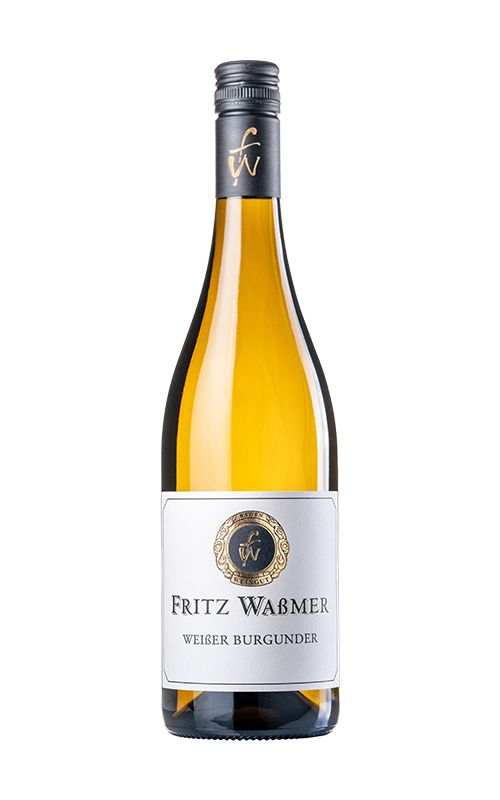
23
Fritz Waßmer, baden
In 1998, Fritz Waßmer took a lifetime of family learning and, with a passion for the vines that was second nature, started his own winery in Bad Krozingen, Baden. Proudly self-taught in the intricacies of winemaking but with generations of viticultural knowledge in his bones, Fritz built on an affinity he felt for Pinot Noir and never looked back. His love for this iconic grape, one of the star varietals of Baden, goes back a long way when Fritz started to develop an admiration for the legendary Burgundy approach to Pinot Noir production. While this is the guiding star grape at Fritz Waßmer, other classic French cultivars like Syrah, Cabernet Franc, Cabernet Sauvignon, and Merlot also have a special place in the winery vineyards. Rarities in leading German wine regions, Chardonnay, Pinot Blanc, Pinot Gris, Sauvignon Blanc, Viognier, and even Auxerrois have been added in recent years. Whether a flagship Pinot Noir or another timeless grape, Fritz’s near-obsession is to enable each unique terroir to shine through in every sip.
2019 Schlossberg Staufen Weisser Burgunder
Full, ripe aromas of apple and peach, plus notes of vanilla burnt caramel - like a crème brûlée without sugar - and fine, flint-stone matches. The palate is opulent, but also fresh - and full to the brim with ripe fruit, salty mineral notes, spiciness and sweet herbs. A long, lively finale is dominated by other sweet herbs, followed by salt. A complex white burgundy that offers excellent drinking fun.
Tasting Notes
Wine Facts
- Pinot Blanc
- Dry
- Qualitätswein, trocken
- Schlossberg Staufen
- South, Southwest
- Shell limestone, Yellow slate
- 0.75Ltr
- 7.2g/l
- 3.5g/l
- 12.5%
- 8-12°C
- Now-2045
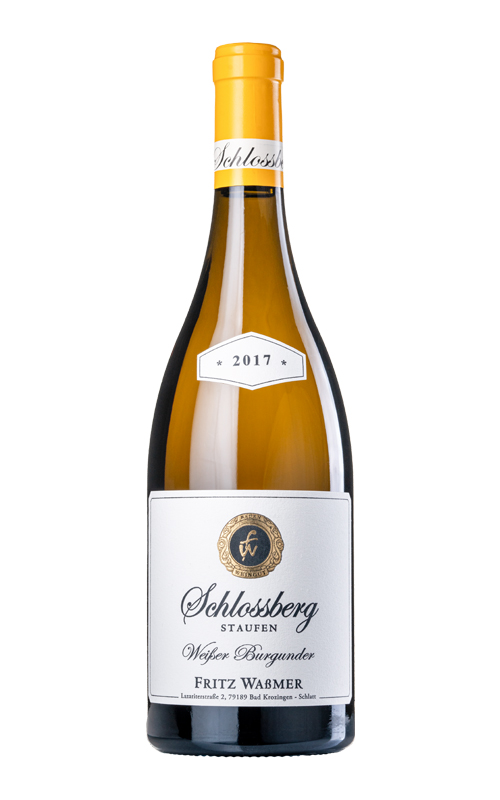
24
Fritz Waßmer, baden
In 1998, Fritz Waßmer took a lifetime of family learning and, with a passion for the vines that was second nature, started his own winery in Bad Krozingen, Baden. Proudly self-taught in the intricacies of winemaking but with generations of viticultural knowledge in his bones, Fritz built on an affinity he felt for Pinot Noir and never looked back. His love for this iconic grape, one of the star varietals of Baden, goes back a long way when Fritz started to develop an admiration for the legendary Burgundy approach to Pinot Noir production. While this is the guiding star grape at Fritz Waßmer, other classic French cultivars like Syrah, Cabernet Franc, Cabernet Sauvignon, and Merlot also have a special place in the winery vineyards. Rarities in leading German wine regions, Chardonnay, Pinot Blanc, Pinot Gris, Sauvignon Blanc, Viognier, and even Auxerrois have been added in recent years. Whether a flagship Pinot Noir or another timeless grape, Fritz’s near-obsession is to enable each unique terroir to shine through in every sip.
2018 Spätburgunder „M“
Smooth and refined with an abundance of aromas of dark fruits such as cherry and blueberry, spicy nuance. The palate is clear, fresh and has very fine tannins, accompanied by dark fruits and some fennel. Very nice balance, refreshing and fruity with finesse, a certain flowery and understatement. A pleasure.
Tasting Notes
Wine Facts
- Pinot Noir
- Dry
- Qualitätswein, trocken
- Limestone
- 0.75Ltr
- 7.2g/l
- 3.5g/l
- 13%
- 18°C
- Now-2035
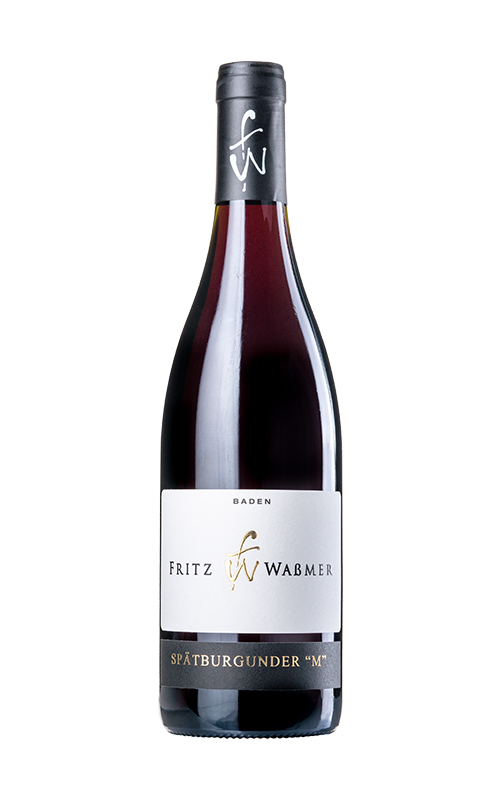
25
Fritz Waßmer, baden
In 1998, Fritz Waßmer took a lifetime of family learning and, with a passion for the vines that was second nature, started his own winery in Bad Krozingen, Baden. Proudly self-taught in the intricacies of winemaking but with generations of viticultural knowledge in his bones, Fritz built on an affinity he felt for Pinot Noir and never looked back. His love for this iconic grape, one of the star varietals of Baden, goes back a long way when Fritz started to develop an admiration for the legendary Burgundy approach to Pinot Noir production. While this is the guiding star grape at Fritz Waßmer, other classic French cultivars like Syrah, Cabernet Franc, Cabernet Sauvignon, and Merlot also have a special place in the winery vineyards. Rarities in leading German wine regions, Chardonnay, Pinot Blanc, Pinot Gris, Sauvignon Blanc, Viognier, and even Auxerrois have been added in recent years. Whether a flagship Pinot Noir or another timeless grape, Fritz’s near-obsession is to enable each unique terroir to shine through in every sip.
2017 Spätburgunder „Alte Reben“
An intense bouquet of fresh, red fruits such as cranberries, red currants, red plums and sour cherries. Clear and fresh on the palate, with juicy, accessible tannins. In addition to the abundance of fruit, freshness and saltiness, it has a long finish that is characterized by youthful cloves. An engaging wine that exceeds all expectations and that will be beautiful for at least another ten to fifteen years.
Tasting Notes
Wine Facts
- Pinot Noir
- Dry
- Qualitätswein
- Limestone
- 0.75Ltr
- 7.2g/l
- 3.5g/l
- 13%
- 18°C
- Now-2045

26
Gut Hermannsberg, nahe
To visit the estate winery of Gut Hermannsberg, one drives on the narrow, winding roads between steep vine-covered slopes through the enchanting Nahe Valley. Once through the entrance gates, you ascend to the 1902 founded Royal Prussian Wine Domaine with unparalleled views. It is like taking a trip back in time. Although the winery is now producing 150,000 bottles annually, the actual footprint of the estate, and the wine cellar, remains unchanged since 1902. That is a testament to the forethought and planning of the original engineers. The sole structural addition is that of a modern “gateway” to the cellar, which is nestled in the courtyard between two of the original buildings. This new copper-clad building is in tribute to the original copper mine which was located on the Kupfergrube vineyard slope. Gut Hermannsberg is unique in that it encompasses seven seven GG/Gran Cru vineyards located in the villages of Schlossbockelheim, Niederhausen, Altenbamberg and Traisen. The GG wines from these areas can take years to fully mature, but the structure of crisp minerality from the slate base, with expressive peach notes, is noted right out of the barrel. The winemaker, Karsten Peter, shares a philosophy with the team, both in the vineyards and the cellar, to let the vines express themselves with very little human intervention. Riesling remains the great love at Gut Hermannsberg and this passion is reflected from the vineyard to the cellar to the tasting room. The wines are the stars and they are treated with the utmost respect and care. The only way to truly experience their “gems in a bottle” is to pop a cork and taste them first hand. Their selection of world-class Rieslings is second to none.
2021 Just Riesling
Juicy and animating! Just Riesling is created with captivating fruit aromas and harmonious acidity. A Riesling that does not deny its origins. Aromas of green apple and citrus with a slight minerality and herbal spiciness lead to a pleasant drinking flow. Youthful and uncomplicated it opens the doors to the Riesling world of Gut Hermannsberg. The Just Riesling refreshes on the terrace and as a light aperitif, harmonizes with seasonal, light cuisine and invigorate carpaccio and ceviche as well as light pasta dishes and salads.
Tasting Notes
Wine Facts
- Riesling
- Dry
- VDP.GUTSWEIN
- Soil diversity of different “Grosse Lagen”
- 0.75Ltr
- 7.6g/l
- 6.4g/l
- 11.5%
- 6-10°C
- Now-2025
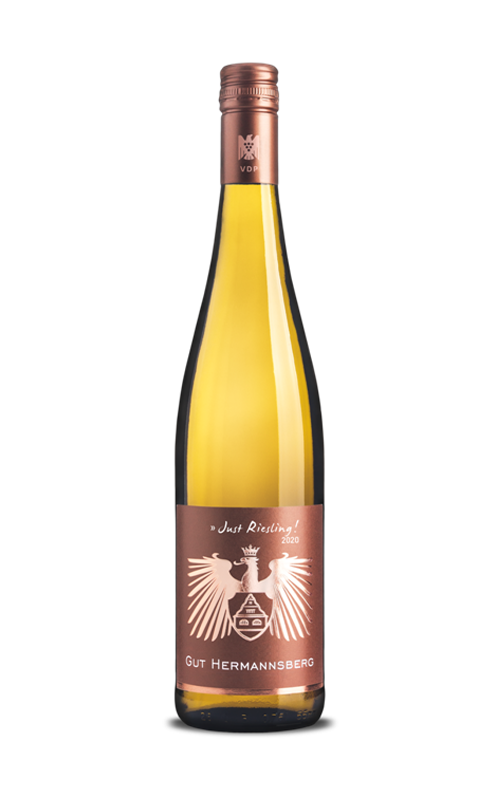
27
Gut Hermannsberg, nahe
To visit the estate winery of Gut Hermannsberg, one drives on the narrow, winding roads between steep vine-covered slopes through the enchanting Nahe Valley. Once through the entrance gates, you ascend to the 1902 founded Royal Prussian Wine Domaine with unparalleled views. It is like taking a trip back in time. Although the winery is now producing 150,000 bottles annually, the actual footprint of the estate, and the wine cellar, remains unchanged since 1902. That is a testament to the forethought and planning of the original engineers. The sole structural addition is that of a modern “gateway” to the cellar, which is nestled in the courtyard between two of the original buildings. This new copper-clad building is in tribute to the original copper mine which was located on the Kupfergrube vineyard slope. Gut Hermannsberg is unique in that it encompasses seven seven GG/Gran Cru vineyards located in the villages of Schlossbockelheim, Niederhausen, Altenbamberg and Traisen. The GG wines from these areas can take years to fully mature, but the structure of crisp minerality from the slate base, with expressive peach notes, is noted right out of the barrel. The winemaker, Karsten Peter, shares a philosophy with the team, both in the vineyards and the cellar, to let the vines express themselves with very little human intervention. Riesling remains the great love at Gut Hermannsberg and this passion is reflected from the vineyard to the cellar to the tasting room. The wines are the stars and they are treated with the utmost respect and care. The only way to truly experience their “gems in a bottle” is to pop a cork and taste them first hand. Their selection of world-class Rieslings is second to none.
2022 7 Terroirs Riesling
The “7 Terroirs” is made 100% out of Gut Hermannsberg 7 VDP.GrosseLagen, which are vinified separately in the cellar and blended afterwards. This spontaneously fermented Riesling cannot deny its making. The complex herbal and smokey-mineral aromas are compelling and can be tasted right after the first sip. On the palate, this wine presents citrus and stone fruit aromas and convinces with its powerful taste and its elegance. The grapes for this wine originate from Gut Hermannsberg seven single vineyards which are all classified as VDP.GrosseLagen by the VDP. The diverse microclimates and soil conditions of our vineyards are all combined in this Riesling. The conditions of the vineyards are determined by steep and stinted slopes and the near by Nahe-River, with its narrow valley. The “7Terroirs” is a universal food companion and works well with grilled, roasted, or baked goods. We love to pair this wine with an Avocado-Salad and grilled prawns.
Tasting Notes
Wine Facts
- Riesling
- Dry
- VDP.GUTSWEIN
- Lemberg-Porphyre, Melaphyre, Clay Slate, Rhyolite
- 0.75Ltr
- 7.6g/l
- 4.0g/l
- 12.5%
- 8-12°C
- Now-2040
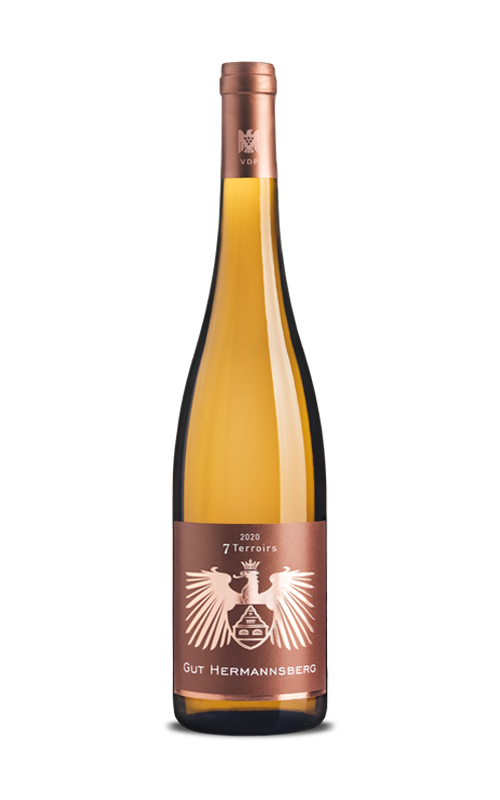
28
Gut Hermannsberg, nahe
To visit the estate winery of Gut Hermannsberg, one drives on the narrow, winding roads between steep vine-covered slopes through the enchanting Nahe Valley. Once through the entrance gates, you ascend to the 1902 founded Royal Prussian Wine Domaine with unparalleled views. It is like taking a trip back in time. Although the winery is now producing 150,000 bottles annually, the actual footprint of the estate, and the wine cellar, remains unchanged since 1902. That is a testament to the forethought and planning of the original engineers. The sole structural addition is that of a modern “gateway” to the cellar, which is nestled in the courtyard between two of the original buildings. This new copper-clad building is in tribute to the original copper mine which was located on the Kupfergrube vineyard slope. Gut Hermannsberg is unique in that it encompasses seven seven GG/Gran Cru vineyards located in the villages of Schlossbockelheim, Niederhausen, Altenbamberg and Traisen. The GG wines from these areas can take years to fully mature, but the structure of crisp minerality from the slate base, with expressive peach notes, is noted right out of the barrel. The winemaker, Karsten Peter, shares a philosophy with the team, both in the vineyards and the cellar, to let the vines express themselves with very little human intervention. Riesling remains the great love at Gut Hermannsberg and this passion is reflected from the vineyard to the cellar to the tasting room. The wines are the stars and they are treated with the utmost respect and care. The only way to truly experience their “gems in a bottle” is to pop a cork and taste them first hand. Their selection of world-class Rieslings is second to none.
2016 Hermannsberg Riesling GG Reserve
We love the unique beauty of our monopoly vineyard “Hermannsberg” which lies right in front of our manor house. The 2016 “Hermannsberg” presents a bouquet of orange zest-, quince- and light yeasty flavors. The clay slate differentiates this vineyard from all the other neighboring, expressive vineyards that usually consist of volcanic rock offering a subtle elegance and precision. The mouthwatering taste of ripe stone fruits, limes and wild herbs is in great balance with a well embedded, racy acidity. A dry, citric finish with light tannins. This wine has a great aging potential. The “Hermannsberg” is the only one out of the 7 VDP.Grosse Lage / Grand Cru vineyard sites with a clay- slate bedrock. This is the source of the elegance and delicate minerality of the “Hermannsberg”-wines. A layer of loess, a wind born sediment, on top of the slate gives the wines their richness. Veal or Poultry Liver with sage and mashed potatoes is a great match with this wine. Dishes cooked with a variation of herbs and powerful spiciness like grilled seabream served with a creamy Risotto.
Tasting Notes
Wine Facts
- Riesling
- Dry
- VDP.GROSSES GEWÄCHS®
- Hermannsberg
- South
- Steep Slope
- Clay Slate, Loess, Melaphyre
- 0.75Ltr
- 8.7g/l
- 3.0g/l
- 12.5%
- 8-12°C
- Now-2040
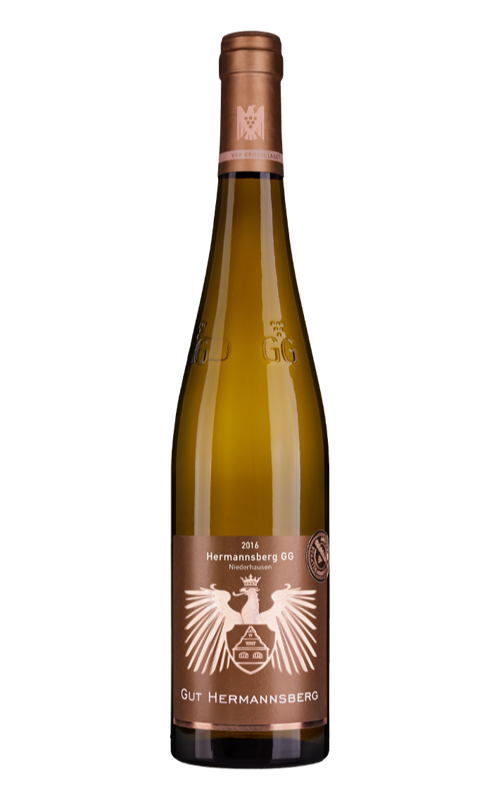
29
Gut Hermannsberg, nahe
To visit the estate winery of Gut Hermannsberg, one drives on the narrow, winding roads between steep vine-covered slopes through the enchanting Nahe Valley. Once through the entrance gates, you ascend to the 1902 founded Royal Prussian Wine Domaine with unparalleled views. It is like taking a trip back in time. Although the winery is now producing 150,000 bottles annually, the actual footprint of the estate, and the wine cellar, remains unchanged since 1902. That is a testament to the forethought and planning of the original engineers. The sole structural addition is that of a modern “gateway” to the cellar, which is nestled in the courtyard between two of the original buildings. This new copper-clad building is in tribute to the original copper mine which was located on the Kupfergrube vineyard slope. Gut Hermannsberg is unique in that it encompasses seven seven GG/Gran Cru vineyards located in the villages of Schlossbockelheim, Niederhausen, Altenbamberg and Traisen. The GG wines from these areas can take years to fully mature, but the structure of crisp minerality from the slate base, with expressive peach notes, is noted right out of the barrel. The winemaker, Karsten Peter, shares a philosophy with the team, both in the vineyards and the cellar, to let the vines express themselves with very little human intervention. Riesling remains the great love at Gut Hermannsberg and this passion is reflected from the vineyard to the cellar to the tasting room. The wines are the stars and they are treated with the utmost respect and care. The only way to truly experience their “gems in a bottle” is to pop a cork and taste them first hand. Their selection of world-class Rieslings is second to none.
2017 Niederhausen Hermannsberg Riesling GG Reserve
We love the unique beauty of our monopoly vineyard “Hermannsberg” which is located directly in front of our manor house. Our “GG RESERVE” wines are handpicked, after a short maceration period spontaneously fermented and staying on the lees in barrels for two more years before bottling. Afterwards we add three years of bottle maturation under perfect conditions in our cellars. The 2017 Hermannsberg GG RESERVE trumps with its deep complexity and a unique play of aromas. It presents a bouquet of orange zest, candied fruits, and light yeasty flavors. Due to the long maturation, the wine developed a complex texture on the palate. The mouthwatering taste of ripe stone fruits, smokey and spicy aromas are in great balance with a well embedded acidity. A dry, citric finish with light tannins. Veal or Poultry Liver with sage and mashed potatoes matches harmoniously with the 2017 Hermannsberg GG RESERVE. It also accompanies dishes cooked with a variation of herbs and powerful spiciness like grilled seabream served with a creamy Risotto. Origin: The “Hermannsberg” is the only one out of the 7 VDP.Grosse Lage/ Grand Cru vineyard sites with a clay-slate bedrock. A layer of loess, a wind born sediment, on top of the slate gives the wines their richness.Melaphyre was brought to the vineyard during mining over 100 years ago.
Tasting Notes
Wine Facts
- Riesling
- Dry
- VDP.GROSSES GEWÄCHS®
- Niederhausen Hermannsberg
- South
- Steep Slope
- Clay Slate, Loess, Melaphyre
- 0.5Ltr
- 8.7g/l
- 5.3g/l
- 13%
- 8-12°C
- Now-2040
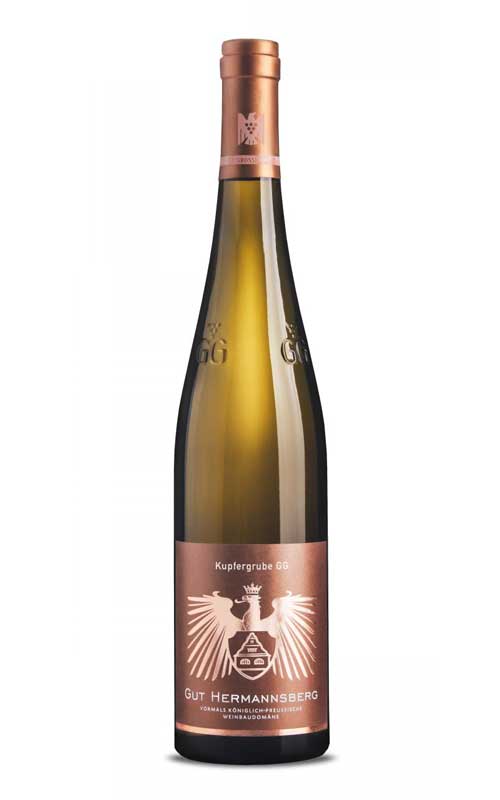
30
Gut Hermannsberg, nahe
To visit the estate winery of Gut Hermannsberg, one drives on the narrow, winding roads between steep vine-covered slopes through the enchanting Nahe Valley. Once through the entrance gates, you ascend to the 1902 founded Royal Prussian Wine Domaine with unparalleled views. It is like taking a trip back in time. Although the winery is now producing 150,000 bottles annually, the actual footprint of the estate, and the wine cellar, remains unchanged since 1902. That is a testament to the forethought and planning of the original engineers. The sole structural addition is that of a modern “gateway” to the cellar, which is nestled in the courtyard between two of the original buildings. This new copper-clad building is in tribute to the original copper mine which was located on the Kupfergrube vineyard slope. Gut Hermannsberg is unique in that it encompasses seven seven GG/Gran Cru vineyards located in the villages of Schlossbockelheim, Niederhausen, Altenbamberg and Traisen. The GG wines from these areas can take years to fully mature, but the structure of crisp minerality from the slate base, with expressive peach notes, is noted right out of the barrel. The winemaker, Karsten Peter, shares a philosophy with the team, both in the vineyards and the cellar, to let the vines express themselves with very little human intervention. Riesling remains the great love at Gut Hermannsberg and this passion is reflected from the vineyard to the cellar to the tasting room. The wines are the stars and they are treated with the utmost respect and care. The only way to truly experience their “gems in a bottle” is to pop a cork and taste them first hand. Their selection of world-class Rieslings is second to none.
2020 Traiser Bastei Riesling GG Late-release
It is one of the most spectacular vineyards in the world. Like an amphitheater, the red rock encloses a small stage on which only the Riesling brings such impressive results. Out of our 7 vineyards, our “Bastei” vineyard is our warmest where ancient vines grow, and their roots reach deep into the hard rhyolite rock. A wine can hardly taste as mineral as the “Bastei GG”. Flint and herbal aromas give this wine its incredible complexity. It has a great tension and at the same time an embracing warmth of ripe fruity aromas. Like a firework, not overburdened but sublime. This will be an extremely great wine in 10, or better said in 15 years. Nonetheless, it is already a brilliant Riesling. We recommend Filet Wellington with beans, bacon and potato gratin. Also, savory jus or roasted dishes work very well with our “Bastei Riesling GG”. Origin: This vineyard lies in front of the highest rock face north of the alps. The vines root deep into the rhyolite rock and are surrounded by cooling winds. The Rotenfels-massif and its huge heat reservoir support the vines. The temperature is usually extremely hot during the day but drops quickly at night. This results in a spectacular wine from a spectacular vineyard.
Tasting Notes
Wine Facts
- Riesling
- Dry
- VDP.GROSSES GEWÄCHS®
- Traiser Bastei
- South
- Steep Slope
- Ryolite
- 0.75Ltr
- 7.2g/l
- 1.9g/l
- 12.5%
- 8-12°C
- Now-2040

31
Gut Hermannsberg, nahe
To visit the estate winery of Gut Hermannsberg, one drives on the narrow, winding roads between steep vine-covered slopes through the enchanting Nahe Valley. Once through the entrance gates, you ascend to the 1902 founded Royal Prussian Wine Domaine with unparalleled views. It is like taking a trip back in time. Although the winery is now producing 150,000 bottles annually, the actual footprint of the estate, and the wine cellar, remains unchanged since 1902. That is a testament to the forethought and planning of the original engineers. The sole structural addition is that of a modern “gateway” to the cellar, which is nestled in the courtyard between two of the original buildings. This new copper-clad building is in tribute to the original copper mine which was located on the Kupfergrube vineyard slope. Gut Hermannsberg is unique in that it encompasses seven seven GG/Gran Cru vineyards located in the villages of Schlossbockelheim, Niederhausen, Altenbamberg and Traisen. The GG wines from these areas can take years to fully mature, but the structure of crisp minerality from the slate base, with expressive peach notes, is noted right out of the barrel. The winemaker, Karsten Peter, shares a philosophy with the team, both in the vineyards and the cellar, to let the vines express themselves with very little human intervention. Riesling remains the great love at Gut Hermannsberg and this passion is reflected from the vineyard to the cellar to the tasting room. The wines are the stars and they are treated with the utmost respect and care. The only way to truly experience their “gems in a bottle” is to pop a cork and taste them first hand. Their selection of world-class Rieslings is second to none.
2020 Rotenberg Altenbamerg Riesling GG – Trocken
The “Rotenberg” vineyard is located in Altenbamberg in the Alsenz Valley. This vineyard is the highest of our 7 vineyards at 250-350 meters above sea level. A cool tension and freshness characterize the image of the “Rotenberg GGs”. The bouquet offers juicy stone fruits, wild herbs, and zests of a tangerine. The combination of multilayered aromas and refreshing acidity give this wine a vivid and powerful structure. A deep minerality and a smooth phenolic taste leads to complexity. This young wine has a long finish and a great aging potential. Enjoy our “2021 Rotenberg Riesling GG” with Sous Vide Pork Belly with beans or with a savory sausage. Origin: The exposed, red-colored rock resemble images taken from the surface of Mars! The grapes grow on steep, south facing slopes whose soils developed during the time of the “Rotliegenden”. The rhyolite soils have a high amount of iron which gives the “Rotenberg” its name. A soft breeze ensures that the grapes ripen slowly.
Tasting Notes
Wine Facts
- Riesling
- Dry
- VDP.GROSSES GEWÄCHS®
- Rotenberg Altenbamerg
- South
- 0.75Ltr
- 8.4g/l
- 2g/l
- 12.5%
- 8-12°C
- Now-2038

32
Gut Hermannsberg, nahe
To visit the estate winery of Gut Hermannsberg, one drives on the narrow, winding roads between steep vine-covered slopes through the enchanting Nahe Valley. Once through the entrance gates, you ascend to the 1902 founded Royal Prussian Wine Domaine with unparalleled views. It is like taking a trip back in time. Although the winery is now producing 150,000 bottles annually, the actual footprint of the estate, and the wine cellar, remains unchanged since 1902. That is a testament to the forethought and planning of the original engineers. The sole structural addition is that of a modern “gateway” to the cellar, which is nestled in the courtyard between two of the original buildings. This new copper-clad building is in tribute to the original copper mine which was located on the Kupfergrube vineyard slope. Gut Hermannsberg is unique in that it encompasses seven seven GG/Gran Cru vineyards located in the villages of Schlossbockelheim, Niederhausen, Altenbamberg and Traisen. The GG wines from these areas can take years to fully mature, but the structure of crisp minerality from the slate base, with expressive peach notes, is noted right out of the barrel. The winemaker, Karsten Peter, shares a philosophy with the team, both in the vineyards and the cellar, to let the vines express themselves with very little human intervention. Riesling remains the great love at Gut Hermannsberg and this passion is reflected from the vineyard to the cellar to the tasting room. The wines are the stars and they are treated with the utmost respect and care. The only way to truly experience their “gems in a bottle” is to pop a cork and taste them first hand. Their selection of world-class Rieslings is second to none.
2015 Schlossböckelheimer Kupfergrube Riesling GG Reserve
Thousands of hours of work were needed at the beginning of the 20th century to transform a former copper mine and rugged rocky terrain into an imposing vineyard and the view of the mighty terraces of the copper mine is unforgettable! This enormous feat of engineering and the great depth of the wines that grow here are awe-inspiring. The floors of this legendary southern exposure consist of volcanic melaphyre and give the wines a smoky note and warm spice. The Kupfergrube GG Reserve tastes as sublime as this skyward striving steep slope! The terraces of the legendary Kupfergrube site rise up in a purely south-facing direction. The Kupfergrube GG Reserve is a wine with power and depth. It does not bang on the table to draw attention to its impressive mineral presence, but slowly draws anyone who is open to it into the depths. The well-known wine merchant and critic Heiner Lobenberg says about the 2016 Kupfergrube GG Reserve: "...the acidity is concise but not hard, it guides the wine. I think in the long run this dryness, which the wine usually has, is a guarantee for the high class of this wine. It is unembellished. One of the great Rieslings from the Nahe and with uncanny reliability. 100/100."
Tasting Notes
Wine Facts
- Riesling
- Dry
- VDP.GROSSES GEWÄCHS®
- Schlossböckelheimer Kupfergrube
- South
- Steep Slope
- Clay Slate, Loess, Melaphyre
- 0.75Ltr
- 8.1g/l
- 5.3g/l
- 12%
- 8-12°C
- Now-2040

33
Gut Hermannsberg, nahe
To visit the estate winery of Gut Hermannsberg, one drives on the narrow, winding roads between steep vine-covered slopes through the enchanting Nahe Valley. Once through the entrance gates, you ascend to the 1902 founded Royal Prussian Wine Domaine with unparalleled views. It is like taking a trip back in time. Although the winery is now producing 150,000 bottles annually, the actual footprint of the estate, and the wine cellar, remains unchanged since 1902. That is a testament to the forethought and planning of the original engineers. The sole structural addition is that of a modern “gateway” to the cellar, which is nestled in the courtyard between two of the original buildings. This new copper-clad building is in tribute to the original copper mine which was located on the Kupfergrube vineyard slope. Gut Hermannsberg is unique in that it encompasses seven seven GG/Gran Cru vineyards located in the villages of Schlossbockelheim, Niederhausen, Altenbamberg and Traisen. The GG wines from these areas can take years to fully mature, but the structure of crisp minerality from the slate base, with expressive peach notes, is noted right out of the barrel. The winemaker, Karsten Peter, shares a philosophy with the team, both in the vineyards and the cellar, to let the vines express themselves with very little human intervention. Riesling remains the great love at Gut Hermannsberg and this passion is reflected from the vineyard to the cellar to the tasting room. The wines are the stars and they are treated with the utmost respect and care. The only way to truly experience their “gems in a bottle” is to pop a cork and taste them first hand. Their selection of world-class Rieslings is second to none.
2017 Schlossböckelheimer Kupfergrube Riesling GG Reserve
The “Kupfergrube Riesling GG Reserve” stayed on the lees in barrels for two years before we bottled the wine and let it mature in our cellars. The handpicked grapes are macerated, pressed, and spontaneously fermented before maturing in oak vats and stainless steel tanks. An expressive wine with aromas of pink grapefruit, yellow apples, intense flint- and smokey fragrances. On the palate the 2017 “Kupfergrube Riesling GG RESERVE” presents an extreme herbal spiciness paired with an aroma reminding of black tea and grapefruit. The impressive structure of acidity adds a youthful freshness. The aftertaste demonstrates the typical strong and salty minerality leading to an impressive complexity. We love to pair the 2017 “Kupfergrube Riesling GG RESERVE” with a loin of saltmarsh lamb with rosemary potatoes and a hearty game-jus. Origin: Melaphyre, volcanic eruptive rock covered by carbonated slate. In the beginning of the last century, it took thousands of hours of hard labor to turn the former copper mine and the surrounding rocky landscape into the unique vineyard now known as “Kupfergrube”. Today the terraces arise purely south oriented. The vines do not forgive any mistakes and demand a high level of containment even in the cellar.
Tasting Notes
Wine Facts
- Riesling
- Dry
- VDP.GROSSES GEWÄCHS®
- Schlossböckelheimer Kupfergrube
- South
- Steep Slope
- Clay Slate, Loess, Melaphyre
- 0.75Ltr
- 8.1g/l
- 5.3g/l
- 12%
- 8-12°C
- Now-2040

34
Gut Hermannsberg, nahe
To visit the estate winery of Gut Hermannsberg, one drives on the narrow, winding roads between steep vine-covered slopes through the enchanting Nahe Valley. Once through the entrance gates, you ascend to the 1902 founded Royal Prussian Wine Domaine with unparalleled views. It is like taking a trip back in time. Although the winery is now producing 150,000 bottles annually, the actual footprint of the estate, and the wine cellar, remains unchanged since 1902. That is a testament to the forethought and planning of the original engineers. The sole structural addition is that of a modern “gateway” to the cellar, which is nestled in the courtyard between two of the original buildings. This new copper-clad building is in tribute to the original copper mine which was located on the Kupfergrube vineyard slope. Gut Hermannsberg is unique in that it encompasses seven seven GG/Gran Cru vineyards located in the villages of Schlossbockelheim, Niederhausen, Altenbamberg and Traisen. The GG wines from these areas can take years to fully mature, but the structure of crisp minerality from the slate base, with expressive peach notes, is noted right out of the barrel. The winemaker, Karsten Peter, shares a philosophy with the team, both in the vineyards and the cellar, to let the vines express themselves with very little human intervention. Riesling remains the great love at Gut Hermannsberg and this passion is reflected from the vineyard to the cellar to the tasting room. The wines are the stars and they are treated with the utmost respect and care. The only way to truly experience their “gems in a bottle” is to pop a cork and taste them first hand. Their selection of world-class Rieslings is second to none.
2019 Steinberg Niederhausen Riesling Trocken GG
This steep cone-shaped hill above our monopole Hermannsberg site is as stony as its name suggests. An important detail is the pale color of the volcanic Lemberg porphyry bedrock, in contrast to the dark melaphry of the Kupfergrube site just a few hundred meters away, and this makes the Steinberg unique. Because the soil of the Steinberg is so pale it remains cool, like the soil in the Grand Cru vineyards of Chablis, where the chalk-richKimmeridgean soil is also pale in color. This gives these wines a sleek and stony personality. Our Steinberg wines (first vintage 2013) are strong characters with great depth, but always tend in the austere direction. They’ve already built a strong following and often sell out long before the next vintage is released.
Tasting Notes
Wine Facts
- Riesling
- Dry
- GG
- Steinberg Niederhausen
- South, Southwest
- Steep Slope
- 0.75Ltr
- 8.7g/l
- 2.6g/l
- 12.5%
- 8-12°C
- Now-2035

35
Gut Hermannsberg, nahe
To visit the estate winery of Gut Hermannsberg, one drives on the narrow, winding roads between steep vine-covered slopes through the enchanting Nahe Valley. Once through the entrance gates, you ascend to the 1902 founded Royal Prussian Wine Domaine with unparalleled views. It is like taking a trip back in time. Although the winery is now producing 150,000 bottles annually, the actual footprint of the estate, and the wine cellar, remains unchanged since 1902. That is a testament to the forethought and planning of the original engineers. The sole structural addition is that of a modern “gateway” to the cellar, which is nestled in the courtyard between two of the original buildings. This new copper-clad building is in tribute to the original copper mine which was located on the Kupfergrube vineyard slope. Gut Hermannsberg is unique in that it encompasses seven seven GG/Gran Cru vineyards located in the villages of Schlossbockelheim, Niederhausen, Altenbamberg and Traisen. The GG wines from these areas can take years to fully mature, but the structure of crisp minerality from the slate base, with expressive peach notes, is noted right out of the barrel. The winemaker, Karsten Peter, shares a philosophy with the team, both in the vineyards and the cellar, to let the vines express themselves with very little human intervention. Riesling remains the great love at Gut Hermannsberg and this passion is reflected from the vineyard to the cellar to the tasting room. The wines are the stars and they are treated with the utmost respect and care. The only way to truly experience their “gems in a bottle” is to pop a cork and taste them first hand. Their selection of world-class Rieslings is second to none.
NV Riesling Sekt Brut
At once light and refreshing, yet elegant and mineral our Riesling Brut has a very attractive balance of apple and citrus aromas with a discreet creaminess from sur lie aging. Since the first release based on 2016 base wines the aging has been extended to a minimum two years in bottle and that considerably improved both the harmony and the texture of the mousse. Now we are very close to perfecting this product that is an important ambassador for our style of Riesling, marrying real character with immediate charm. As well suited to drinking with fish dishes as by itself our Riesling Brut has a lightness and freshness that appeals to everyone who likes the wines of this grape or other crisp dry white wines and/or lighter champagnes. Winemaking: Champagne method with the second fermentation in bottle and at least two years on the lees in bottle.
Tasting Notes
Wine Facts
- Riesling
- Dry
- VDP.Gutssekt
- Volcanic Soil
- 0.75Ltr
- 9.3g/l
- 7.1g/l
- 12%
- 6-8°C
- Now-2025
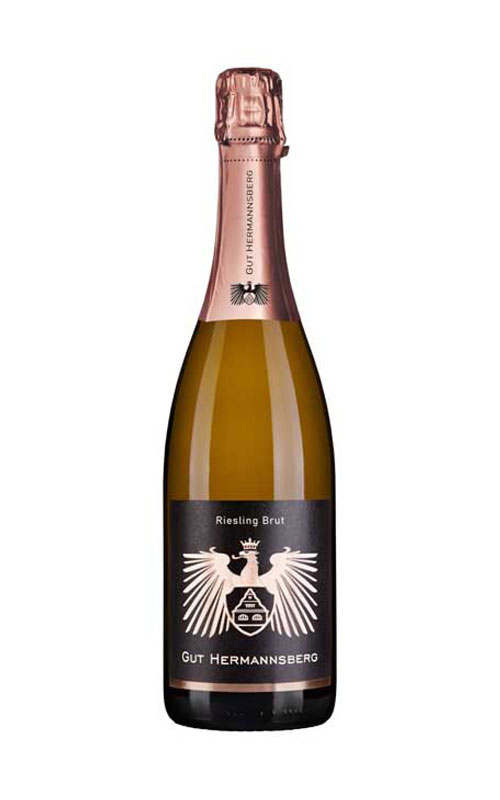
36
Jean Stodden, ahr
For Alexander Stodden, owner and cellarmaster at Ahr winery Jean Stodden, balancing tradition with just the right amount of innovation is an approach that’s worth the effort. A family estate that has shaped the tastes of wine lovers over generations, ungrafted century-old vines (a rarity in Ahr) and old-school diligence, counterbalance the latest vineyard and winery techniques that are only introduced if necessary and at precisely the right moment. At the core of operations is his heartfelt passion: Spätburgunder, and while Alexander can’t name a favorite since he loves his “children” equally, he pinpoints Spätburgunder JS as the perfect entry point into the Stodden wines. Jean Stodden joined the VDP in 2005. Its main grape variety is Spätburgunder, and it also cultivates small quantities of Riesling and Frühburgunder across 8.5 acres.
2018 Herrenberg Spätburgunder Vdp.Grosses Gewächs
Cool scent of minerals. Pure ripe fruit with toasted notes, firm tannins, on the palate The handpicked and strictly selected Pinot Noir grapes are fermented in the mash tank for 18 days. The malolactic fermentation took place in the barrique barrel. The RecherHerrenberg was matured and stored in 100% new oak barrels for 18 months Unfiltered. The name Herrenberg refers to the Lords of Saffenburg, who owned the village of Rech and who planted their vineyards in this prime location. The vineyard lies below the rocky part of the Schwedenkopf. The southern part of the site, opposite the Saffenburg ruins, is terraced. With its weathered slate soil with greywacke, the steep slope facing south, with a slope of up to 60%, offers excellent conditions for optimal intake of the sun.
Tasting Notes
Wine Facts
- Pinot Noir
- Dry
- VDP.Gewächs
- Herrenberg
- South
- 40%
- Weathered slate soil with greywacke
- 0.75Ltr
- 6.0g/l
- 1.3g/l
- 13%
- 16°C
- Now-2045
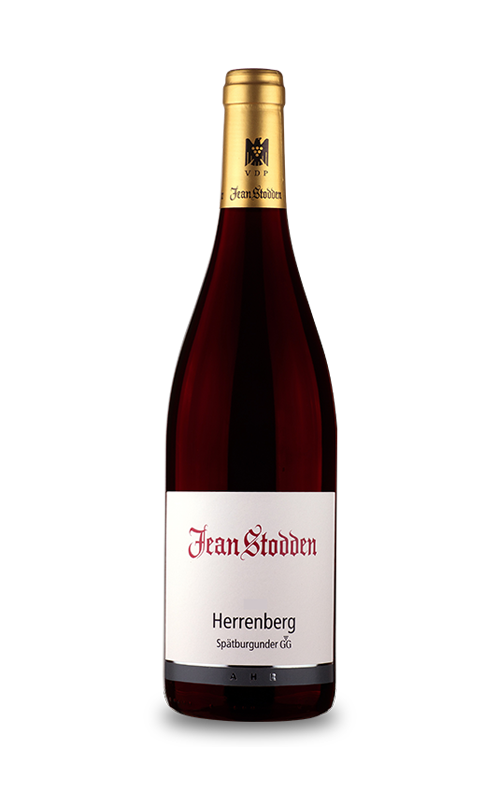
37
Nelles, ahr
Father and son team Thomas and Philip Nelles’ philosophy is “tradition obliges” – and there is plenty of that for a winery opened in 1479. With vineyards in the Heimersheimer Landskrone and Burggarten at Ahr’s eastern end, grapes are of premier quality and vinification is meticulous to preserve each wine’s terroir. Sustainability is a key driving force in Nelles’ winemaking. The winery is a member of Fair ‘n Green and encourages all the little critters in their vineyards to find their natural places among the vines, enriching the ecosystem. In the cellar, reds are barrel matured with “controlled inactivity” to capture the distinct quality and minerality of each vineyard. Nelles produces 60,000 bottles annually and has been a VDP member since 1994.
2019 B-52 Spätburgunder Burggarten GG
This top Pinot Noir grew on the steep slopes of the Estate’s oldest vineyards in Heimersheim. The yield from these 40 year old vineyards is very low. The grapes were picked by hand and picked again on the reading table. The wine has found its perfection after 15 months of storage in barriques. Opulent pinot scent, dense fruit substance and the finest roasted aromas accompany this wine on the tongue and show an enormous length and fullness on the palate.
Tasting Notes
Wine Facts
- Pinot Noir
- Dry
- VDP.Gewächs
- HeimersheimerLandskrone
- South
- 50%
- Slate
- 0.75Ltr
- 6.0g/l
- 1.3g/l
- 13%
- 16°C
- Now-2040
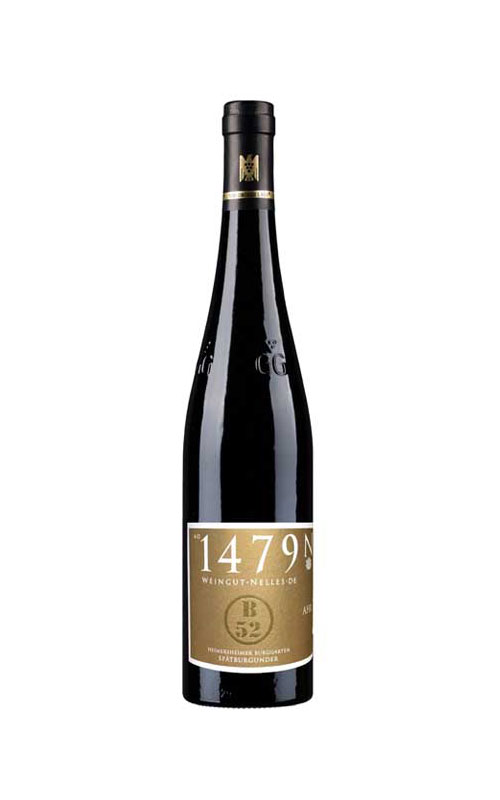
38
Stromberg Zabergäu, württemberg
Immerse yourself in Württemberg wine country with wines from the two most important vineyards in this region: Heuchelberg and Stromberg. Experience grape varieties and wines that leave nothing to be desired. Around 1,000 Weingärtner (the Swabian term for wine growers) cultivate around 690 hectares of vineyards around the Stromberg and Heuchelberg. The Weingärtner Stromberg-Zabergäu eG is the largest wine grower cooperative in Württemberg. The headquarters of the cooperative is based on the outskirts of Brackenheim, the Weinkeller Brackenheim. The Strombergkeller, the second location of the cooperative, is in Bönnigheim.
2019 Pinot Meunier Sparkling Rosé
The wine is made in traditional bottle fermentation (Flaschengärung) with 17 months on the lees. The wine has a dense aroma of ripe apples with subtle toasty notes of fresh bread and a hint of dried raspberries. Crisp and fresh on the palate with flavors of peach and nectarine, with a creamy, elegant texture and a great lengthy finish. This is a very special wine that was made with a lot of time and passion to create this first-class sparkling, tingling pleasure experience that Champagne lovers like so much. Pinot Meunier is a little diva in the vineyard, it demands a lot of skill and experience from the winemaker to obtain perfect grapes, which are then pressed whole.
Tasting Notes
Wine Facts
- Pinot Meunier
- Dry
- Sekt b.A
- Stromberg
- Shell limestone
- 0.75Ltr
- 5.6g/l
- 1.5g/l
- 12.5%
- 8-10°C
- Now-2035
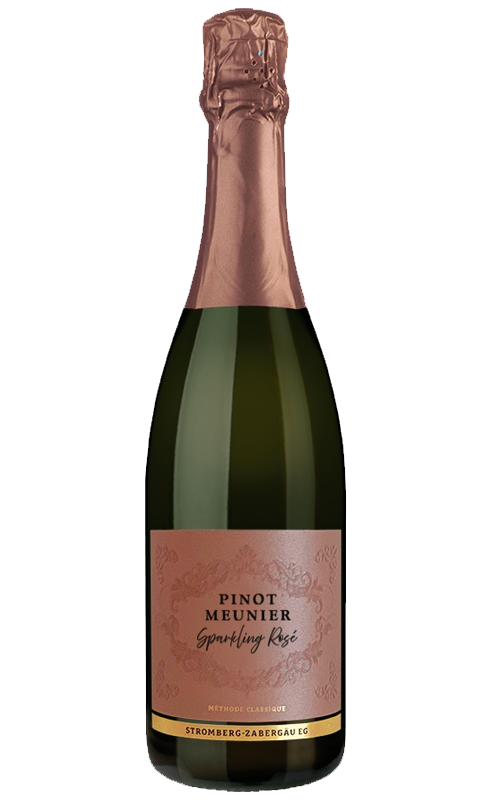
39
Thörle, rheinhessen
Rheinhessen vintners have been at the forefront of winemaking innovation for years and the Thörle winery, situated in Saulheim, is a classic example of a perfectionist approach in the vineyard and winery. Run by brothers Christoph and Johannes Thörle since 2006, the winery was handed down from their parents with viticulture in the family since the 1500s. The brothers have swiftly homed in on the production of Riesling, Pinot Noir, white Burgundy varieties and Silvaner to the highest standards. In the vineyard, they hand-harvest low yields and vinify with laser-like precision for each varietal in a new spacious state-of-the-art, custom-built winery. The result is a range of unforgettable wines that display the rich mineral character of the surrounding limestone soils. The drive for perfection in Germany’s highest-producing region, plus homage to centuries of a family’s dedication, are what motivates the two brothers to passionately craft the finest wines today.
2019 Saulheim Spätburgunder Kalkstein
On the nose a hint of violets and intense aromas of wild forest berries and morello cherries, which are subtly underlaid with fine woody spice. On the palate a hint of herbaceous mint, fresh acidity and an endlessly long salty-mineral finish. The grapes were harvested by hand with an optimal balance of aroma, acidity and ripeness. The time of harvest is particularly important for Pinot Noir. This Pinot Noir, rich in extract, spontaneously fermented on the mash for 20 days, was stored in high-quality French oak barrels for a period of 21 months (25% new barrels and 75% older barrels).
Tasting Notes
Wine Facts
- Pinot Noir
- Ortswein
- Saulheim
- Limestone
- 0.75Ltr
- 6.6g/l
- 1.1g/l
- 13%
- 16°C
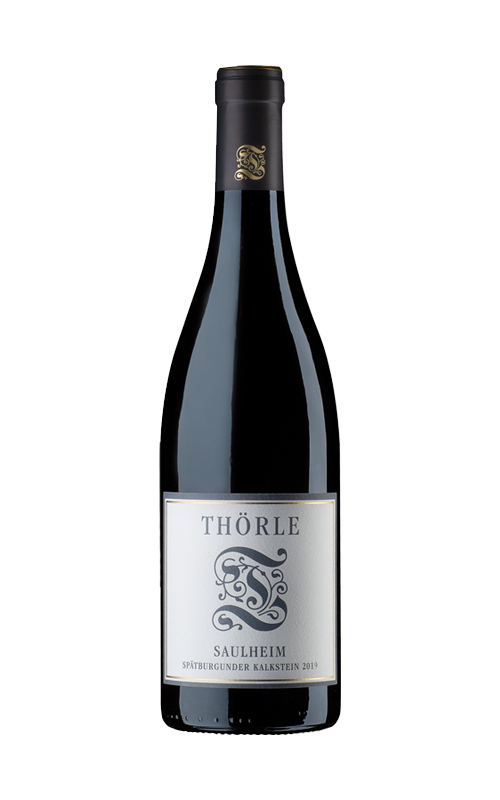
40
Contact
Phone Number
T: 917 935 9305Jan Schüler
Founder & CEOEmail Address
E: jan@wunderwein.comNY Local Delivery Schedule
| Destination | Delivery Days* |
|---|---|
| Manhattan | M-F |
| Brooklyn/Queens/Bronx/Staten Island | M-F |
| S. Westchester (South of Rt.287) | M-F |
| N. Westchester (North of Rt. 287) | Tu-F |
| Nassau | M-F |
| Suffolk | W,F |
| Hamptons (Centerville/W. Hampton/Eastward)* | T,Th,F* |
| Shelter Island | W,F |
| Putnam | T-F |
NJ Local Delivery Schedule
| Destination | Delivery Days* |
|---|---|
| Bergen | Tu-F |
| Hudson | Tu-F |
| Essex | Tu-F |
| Passaic | Tu-Th |
| Union | Tu-F |
| Middlesex | Tu,W,F |
| Morris | Tu-Th |
| Somerset | W,F |
| Monmouth | Tu,W,F |
| Warren/Sussex | Tu,Th |
| Ocean | Th |
| Burlington/Mercer | W,F |
| Hunterdon | W,F |
| Camden | Th |
| Gloucester/ Salem | Th |
| Atlantic/Cape May/ Cumberland | T,Th |
*Delivery schedule subject to change due to several factors, including holidays, seasonality and weather. In addition, please note that the delivery days stated in the grid above pertain to the metro areas of the counties mentioned for the most part. Some cities/areas in certain counties have a limited delivery schedule. For a full listing of the delivery schedule by city, county and zip code please visit the following website: http://westerncarriers.com/delivery-regions.cfm
Notes
- Local picking fee will apply
- Deliveries to customers on C.O.D. will incur a $35.00 fee. Customer must have a check ready at time of delivery.
- Deliveries requested after 5:30pm will incur a $35 fee
- Waiting time: after 20 minutes of waiting time, $35.00 will be charged per ½ hour
- Fuel Surcharge is scaled to current gas price
- Pick-ups are same as delivery charge van rates
- From May to September, delivery frequency will increase to Ocean, Atlantic, and Cape May due to the summer travel season.


